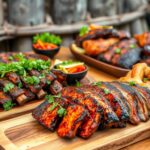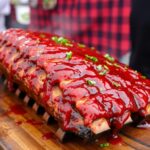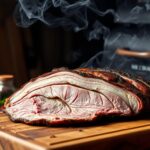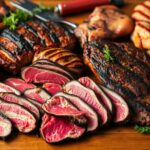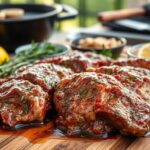Uncategorized
How to Build Flavor Layers with Mops, Sprays, and Sauces
Ever wondered how chefs and pitmasters make their grilled and smoked meats so delicious? It’s all about using mops, sprays, and sauces. These tools help create deep, complex flavors. By learning how to baste and glaze, you can improve your outdoor cooking. Every bite will be full of amazing tastes.
This guide will show you how to layer flavors with mops, sprays, and sauces. You’ll learn to balance sweet, savory, and spicy flavors. You’ll also see how to get the perfect bark and smoke ring. These are the secrets pros use to make ordinary meats taste like gourmet dishes.
Key Takeaways
- Unlock the secrets of flavor layering with mops, sprays, and sauces
- Achieve complex, multi-dimensional flavor profiles in your grilled and smoked meats
- Master the art of basting and glazing to take your outdoor cooking to new heights
- Balance sweet, savory, and spicy notes for a perfectly balanced flavor profile
- Discover the techniques that professional chefs use to create mouthwatering results
Are you ready to improve your grilling skills and wow your friends and family? Let’s explore how to make irresistible flavor layers with mops, sprays, and sauces.
The Art of Basting: Why Mop, Spritz, or Baste?
Basting your meat with mops, sprays, and sauces can change the game. It adds layers of flavor and aroma. These techniques also help remove excess spices, reduce shrinkage, and extend cooking time.
Adding Flavor and Aroma
Regularly basting your meat with a flavorful mop or spritz adds layers of taste and smell. The liquid soaks into the meat, making it bold and unique. Your guests will want more.
Removing Flavors and Spices
Strong marinades or spice rubs can overpower your meat. Basting with liquids like apple cider vinegar or broth balances out the flavors. This leaves you with a tasteful and enjoyable dish.
Reducing Shrinkage
Frequent basting prevents meat from shrinking too much. The liquid keeps proteins hydrated and intact. This results in a juicier and more tender final product.
Extending Cooking Time
Regular mopping or spritzing slows down cooking. It helps you achieve the right doneness without overcooking. This is great for larger cuts that take longer to cook.
Learn the details of each basting method to get the best results. Try different mop ingredients and spritz benefits. Find the perfect mix for your basting techniques and cooking time considerations.
Mastering the Mop: Ingredients and Techniques
Making the perfect mop sauce is like an art. It needs the right mix of ingredients and a good sense of flavor balance. Whether you like the zing of vinegar or the sweet taste of fruit juice mops, the secret is finding flavors that match your BBQ.
Choosing Liquids: Juices, Vinegars, and More
The base of any mop sauce is its liquid. Try using different juices like tangy apple cider or sweet pineapple to deepen your mop’s flavor. Vinegars can add a nice acidity. For some heat, add spicy things like hot sauce or chili peppers.
Balancing Flavors: Sweet, Savory, and Spicy
What makes a mop sauce special is balancing sweet, savory, and spicy tastes. Mix things like honey, brown sugar, or molasses for a sweet glaze. Add soy sauce, Worcestershire, or coffee for a savory umami taste. And don’t hesitate to use spices and chilies for extra flavor.
“The key to a truly memorable mop is finding the perfect harmony between sweet, savory, and spicy elements.”
By getting good at flavor balancing, you can take your barbecue to new levels. This opens up a world of delicious possibilities.
Flavor layers with mops and sauces
Discover the secrets of flavor layering with mops and sauces. These tools can turn your grilled or smoked meats into a feast of barbecue sauce reductions and marinade techniques. This makes your meals more enjoyable.
Begin with a tasty marinade. Mix acids, sweeteners, and spices to make a base that infuses your meat with flavor. As it cooks, mop it with a flavorful liquid. This lets the juices soak back in and fills every bite with aroma.
The real magic is in barbecue sauce reductions. Reduce rich sauces to intensify their flavors. Then, use them to baste your meat near the end of cooking. This creates a caramelized, shiny outside that locks in the smoky, sweet, and savory tastes you’ve worked on.
| Mop Ingredients | Sauce Reduction Ingredients |
|---|---|
|
|
With some trial and a lot of love, you can make your own flavor layering methods. This will take your mops and sauces to barbecue perfection.
The Smoke Ring: Enhancing Color and Flavor
The smoke ring is more than just a pretty color. It also boosts the flavor of your barbecue. Let’s dive into how moisture and a chemical reaction between nitrite and myoglobin make it happen.
When meat meets smoke, a cool chemical reaction starts. Nitrogen compounds and oxygen mix with myoglobin in the meat. This mix creates a pinkish-red color, known as the smoke ring. It can go deep into the meat.
Keeping meat moist is key for a great smoke ring. Moisture lets smoke and nitrogen compounds go deeper into the meat. The type of wood, cooking temperature, and how long you smoke all matter for the perfect smoke ring.
“The smoke ring is not just a visual treat, but it can also contribute to the overall flavor profile of your barbecue. Understanding the science behind its formation can help you achieve the perfect smoke ring every time.”
Learning about smoke ring formation can take your barbecue to the next level. It’s great for both experts and backyard grillers. It adds new flavors and textures to your smoked meats.
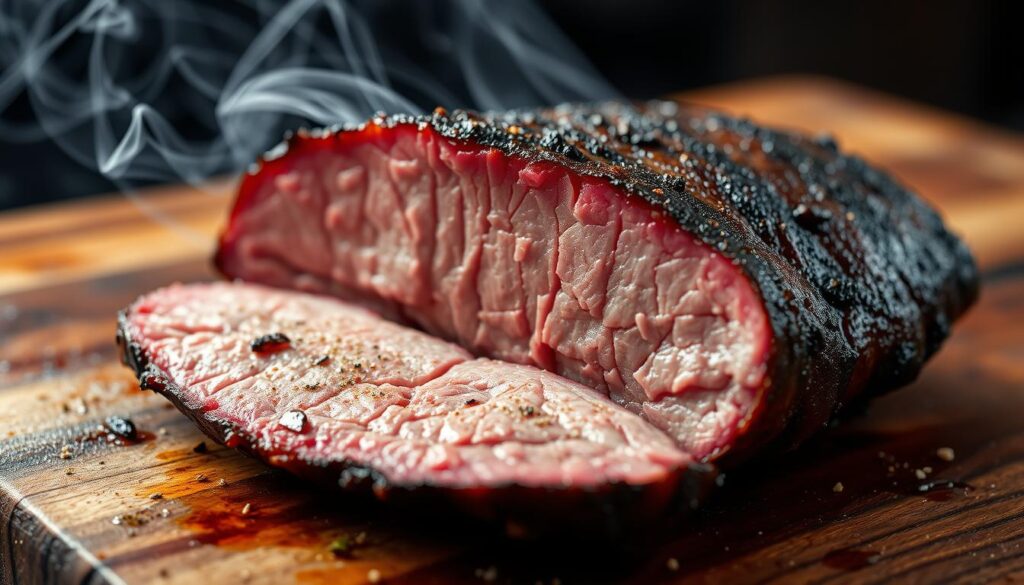
| Factors Affecting Smoke Ring Formation | Impact |
|---|---|
| Moisture content in the meat | High moisture helps smoke and nitrogen-based compounds penetrate the meat, resulting in a deeper and more vibrant smoke ring. |
| Wood type used for smoking | Different wood types, such as hickory or oak, can produce varying levels of nitric oxide, affecting the smoke ring formation. |
| Cooking temperature and duration | Higher temperatures and longer cooking times can enhance the chemical reactions that create the smoke ring. |
Bark Formation: Achieving the Perfect Crust
Making the perfect barbecue bark is like an art. It’s all about controlling browning, caramelization, and moisture. This crust adds a nice texture and brings out amazing flavors, making your barbecue better.
Browning and Caramelization
The secret to a tasty bark is the Maillard reaction and caramelization. When meat gets hot, sugars and amino acids on the surface react. This makes the meat brown and adds flavors like savory, nutty, and sweet.
Crust Texture: Crispy or Sticky?
What kind of crust you like is up to you. It’s about finding the right balance between dry and moist. A crispy bark needs careful moisture control, letting the surface dry and caramelize. For a sticky crust, keep it moist for a glossy look.
To get the crust you want, pay attention to how you cook and baste your meat. Try different rubs and sauces to find the best mix for your barbecue.
“The perfect bark is the culmination of a lifetime of barbecue mastery, where every element – from the rub to the cooking technique – comes together in harmonious perfection.”
Timing is Everything: When to Mop or Spritz
Timing is key when making delicious flavor layers on grilled or smoked meats. Knowing the best mopping and spritzing times helps achieve perfect crust formation and temperature considerations.
Start basting your meat once it starts to form a crust. This usually happens after 30-45 minutes of cooking, depending on the meat’s size and type. Mopping too early can mess up the bark. Waiting too long can leave your meat dry and flavorless.
- Mop or spritz your meat every 30-45 minutes after the initial crust has set, being careful not to remove too much of the rendering fat and juices.
- Pay close attention to the temperature of your grill or smoker, adjusting as needed to maintain the ideal environment for crust formation.
- Experiment with different mopping and spritzing intervals to find the perfect rhythm for your specific recipe and cooking setup.
Mastering when to mop and spritz will help you make the most flavorful and visually stunning smoked or grilled meats your guests have ever had.
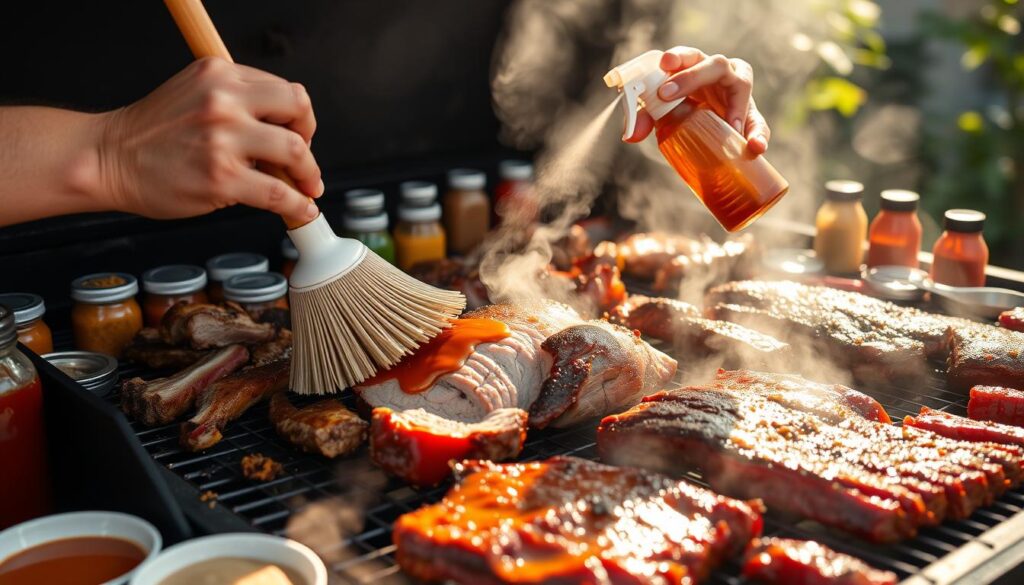
“The secret to the perfect bark lies in the rhythm of your mop or spray bottle.”
Mopping vs. Spritzing: Pros and Cons
Choosing between mopping and spritzing can change how your barbecue tastes and how long it cooks. Both methods have their own benefits and things to think about. Let’s look at what makes each one special to help you pick the best for your meal.
Flavor Impact
Mopping puts a liquid directly on the meat, giving it strong flavors. This method is great for those who want a bold taste. On the other hand, spritzing uses a spray bottle to add flavor. It gives a light, even taste and a nice smell to the meat.
Cooking Time Considerations
How long it takes to cook is important when deciding between mopping and spritzing. Mopping can make cooking longer because the meat absorbs the liquid. This is good for tougher meats that cook better slowly. Spritzing doesn’t slow down cooking much because the liquid evaporates fast, keeping the cooking time steady.
Choosing between mopping and spritzing depends on what you like, the dish you’re making, and what flavor and cooking time you want. Try both methods to see which one works best for your grilling or smoking. This will improve your mopping vs. spritzing experience.
Food Safety: Avoiding Contamination
When you’re basting your meat, keeping it safe is key. If you don’t handle it right, harmful microbes can get back onto the meat. This can make your food unsafe. Here are some important steps to follow for food safety:
- Keep the meat at the right temperature. This kills harmful foodborne pathogens. It’s crucial when you use marinades or sauces with raw meat.
- Keep raw and cooked meats apart. Use different utensils and surfaces for each. This stops bacteria from spreading.
- Clean and sanitize everything you use for basting. This keeps microbes away and stops them from growing.
- Throw away any basting liquid that touched raw meat. Make a new batch to keep your meat safe.
By following these steps, you can make your food taste great without risking anyone’s health.
| Best Practices for Safe Basting | Benefits |
|---|---|
| Maintain Strict Temperature Control | Kills foodborne pathogens and ensures food safety |
| Separate Raw and Cooked Meats | Prevents cross-contamination |
| Regularly Clean and Sanitize Equipment | Eliminates the risk of microbe growth and spread |
| Discard Contaminated Basting Liquids | Promotes meat pasteurization and food safety |
These easy steps will make sure your basting makes your food taste better without risking anyone’s health.
Conclusion
Mastering the art of flavor layers is key to grilling and smoking success. By learning about basting techniques, you can create amazing aromas and tastes. Try different liquids and seasonings to match your taste and cooking style.
Improving your meats’ smoky flavor or achieving a crispy crust is possible with the right barbecue techniques. The journey of mastering grilling is exciting. Enjoy the process and show off your cooking skills with every delicious bite.
You now have the knowledge to make your backyard BBQs unforgettable. Use your new skills to impress everyone. Start this tasty journey and let your love for great barbecue be seen.
FAQ
What are the benefits of basting meat with mops, sprays, and sauces?
Basting your meat adds flavor and aroma. It also removes excess spices or marinades. This can slightly reduce shrinkage and extend cooking time.
How do I create the perfect mop sauce?
To make the perfect mop sauce, pick your ingredients carefully. Use juices, vinegars, spirits, and other liquids for unique flavors. Balance sweet, savory, and spicy tastes.
How can I use mops and sauces to build complex, multi-dimensional flavors?
Use mops and sauces to add layers of flavor from start to finish. Experiment with ingredients and techniques to create your unique barbecue style.
What is the significance of the smoke ring, and how can I achieve it?
The smoke ring adds to your barbecue’s flavor and look. It forms through a chemical reaction in the meat, helped by moisture and smoke.
How can I achieve the perfect barbecue bark?
Creating a flavorful bark is key to great barbecue. Learn about the browning and caramelization processes. Balance moisture for the bark you like.
When is the best time to apply mops or sprays?
Apply mops or sprays after the meat starts to crust. This helps the bark form well and adds moisture and flavor effectively.
What are the differences between mopping and spritzing, and when should I use each technique?
Mopping and spritzing affect your barbecue’s flavor and cooking time differently. Choose the method that fits your dish and preferences best.
How can I ensure food safety when basting my meat?
Be careful with basting to avoid food safety issues. Make sure you’re not adding harmful microbes back onto the meat. Always use clean tools and keep temperatures right.
Best Practices for Cleaning and Maintaining Your Smoker
Do you want your smoker to work great and make delicious food every time? The key is in cleaning and maintenance. But what are the best ways to take care of your smoker? Let’s explore the top tips that will improve your smoking skills.
Key Takeaways
- Understand the importance of regularly cleaning and maintaining your smoker for optimal performance.
- Discover the best practices for routine post-use cleaning, deep cleaning, and seasoning your smoker.
- Learn how to prevent rust and corrosion, clean and maintain accessories, and properly store your smoker.
- Implement practical tips to keep your smoker spotless and ensure consistently delicious smoked meats and vegetables.
- Unlock the secrets to extending the lifespan of your prized smoker and elevating your backyard barbecue game.
Introduction to Smoker Maintenance
Keeping your smoker in good shape is key for great flavor and performance. Regular cleaning and care boost the quality of your smoked dishes. They also make your smoker last longer. By knowing how to maintain your smoker, you can get the best out of it and enjoy tasty results.
Why Cleaning and Maintaining Your Smoker is Important
Regular maintenance has many benefits. It stops ashes, grease, and other residues from building up. These can ruin the flavor and quality of your smoked foods. Over time, they can also damage your smoker.
Regular care keeps your smoker working well. This means you can get great results every time.
Overview of Best Practices
This guide will show you how to clean and maintain your smoker right. You’ll learn about:
- Routine cleaning after each use to remove ash and debris
- Seasoning your smoker to create a protective coating
- Performing deep cleaning and reseasoning as needed
- Preventing rust and corrosion
- Cleaning and maintaining smoker accessories
- Preparing your smoker for storage and bringing it out of storage
- Additional tips for keeping your smoker clean and in top condition
By following these best practices, your smoker will stay in great shape. You’ll get consistent and delicious results for years.
Routine Cleaning After Each Use
Keeping your smoker clean is key for great performance and long life. After each use, clean it to remove ash, grease, and residues. This keeps your smoker looking good and stops corrosion and uneven heating.
Preheating for Easier Cleaning
Start by heating your smoker to about 400°F. The heat makes hard deposits soft, making them easy to clean. This step makes cleaning easier and more effective.
Wire Brushing to Remove Ash
With the smoker hot, use a steel wire brush to clean the inside. Clean walls, grates, and the firebox of ash. It’s important to remove all ash to avoid corrosion and problems later.
Wiping Down Surfaces
After removing ash, use a warm, damp cloth to clean the inside. This removes food residues, sauces, or seasonings left behind. Make sure to clean the door seals and hard-to-reach spots well.
Following these cleaning steps after each use keeps your smoker in great shape. It ensures it continues to cook delicious food for years.
Seasoning Your Smoker
Seasoning your smoker is key to keeping it in good shape and preventing rust. It makes a protective, non-stick layer inside the smoker, like seasoning a cast-iron pan. This layer keeps moisture away and stops residues from building up, which can ruin the taste of your smoked foods.
The Importance of Seasoning
Seasoning your smoker has many benefits. It helps:
- Protect the inside from rust and corrosion
- Make cleaning easier with a non-stick surface
- Keep your smoked foods tasting great by stopping residue buildup
- Make your smoker last longer
Step-by-Step Guide to Seasoning
To season your smoker, just follow these easy steps:
- Spread a high-heat cooking oil, like canola or grapeseed oil, on the inside, including walls and racks.
- Heat the smoker to 250°F to 275°F and run it for 2-3 hours. This lets the oil sink into the metal, making a tough, non-stick layer.
- Season your smoker 2-3 times a year, or when you do a deep clean.
Seasoning your smoker often keeps it in great shape and makes sure your smoked foods always taste amazing.
Deep Cleaning and Reseasoning
Regular upkeep is key, but deep cleaning your smoker every 6 months to a year is also vital. Look out for heavy grease buildup, rust, or changes in performance or flavor. These signs mean it’s time for a deep clean.
Burn Off Residues
Start by lighting a fire in your smoker with the vents wide open. This burns off grease, soot, and residues. Let the smoker cool before moving on.
Washing and Degreasing
After cooling, use warm water and a degreaser to wash the inside. Focus on the firebox, grates, and hard-to-reach spots. Rinse the smoker and let it dry fully.
Reseasoning After Deep Clean
After cleaning, re-season your smoker to protect it from rust. Use a high-heat cooking oil and heat the smoker to 250°F-275°F for 2-3 hours. This seals the metal and makes it non-stick.
These steps keep your smoker in great shape and ensures delicious smoky flavors. Regular care is crucial for a long-lasting smoker.
Cleaning and maintaining smoker
Keeping your smoker clean is key to making delicious smoked dishes. Regular cleaning helps your smoker last longer and keeps food tasting great. By following simple steps, you can keep your smoker working well and enjoy regular smoker maintenance.
The Importance of Keeping Your Smoker Clean
A clean smoker is better in many ways. It keeps the temperature and airflow right for smoking. Ash and grease can block airflow, making your food cook unevenly. A clean smoker also doesn’t rust as much, saving you money and trouble.
Keeping your smoker clean has big benefits. It makes food taste better, keeps it safe to eat, and makes smoking more fun.
Establishing a Maintenance Routine
To keep your smoker running well, make a cleaning schedule. Clean it after each use by preheating it, brushing the inside, and wiping down surfaces. Do a deep clean every few uses, including burning off old food, washing, and seasoning the inside.
| Routine Cleaning | Deep Cleaning |
|---|---|
|
|
Stick to a cleaning routine to keep your smoker great. This way, you’ll enjoy the importance of regular smoker maintenance for a long time.
“A well-maintained smoker is the secret to consistently delicious smoked foods.”
Preventing Rust and Corrosion
Keeping a smoker in good shape is rewarding, but stopping rust and corrosion is a big challenge. It’s important to check your smoker often for rust signs. Look closely at the inside and outside for any rust spots, especially where it gets wet like the firebox and grates.
Inspecting for Rust
Spotting rust early helps stop it from getting worse. Watch for these rust signs:
- Discoloration on the metal surfaces
- Pitting or small holes in the metal
- Flaky or powdery rust deposits
Acting fast when you see rust can save your smoker.
Removing and Treating Rust
When you find rust, deal with it right away. Use a wire brush or sandpaper to get rid of loose rust, then clean the spot well. After cleaning, use a paint or sealant that can handle high heat to protect the metal and stop more rust.
Checking for and treating rust regularly keeps your smoker working well for a long time.
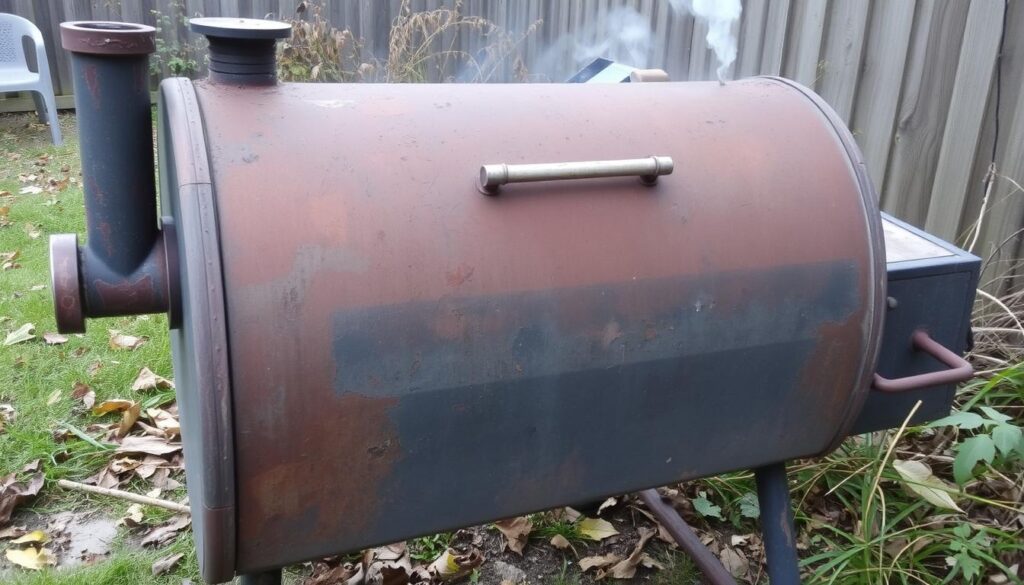
“A well-maintained smoker is the foundation of delicious, flavorful barbecue.”
Cleaning and Maintaining Accessories
Keeping your smoker in great shape is key, but don’t forget about your accessories too. Pay special attention to your cooking grates and the rubber gaskets or seals. They need regular care to work well.
Cleaning Cooking Grates
After smoking, quickly wipe the cooking grates with a damp cloth. This removes stuck-on food or residue that can affect heat and cause problems later. For a deep clean, soak the grates in warm, soapy water or put them in the dishwasher if they can go in it.
Keeping your smoker’s cooking grates clean is key for good performance. It also helps food not stick during your next smoke.
Maintaining Rubber Gaskets
The rubber gasket or seal around your smoker’s door or lid is also important. These seals keep the right temperature and smoke levels inside. So, take care of them.
After smoking, clean the gasket with a damp cloth to remove smoke residue or food particles. Sometimes, apply a bit of food-grade silicone lubricant to keep it flexible and prevent damage.
By cleaning and maintaining your smoker’s grates and gaskets, you help them last longer. This means you’ll get tasty, well-cooked food for many years.
Storage and Seasonal Maintenance
If you live in a place with clear seasons and don’t use your smoker all year, you need to prepare it for storage right. Before you put it away, clean the inside and outside well. Remove any ash, grease, or residue. Clean the cooking grates and make sure the smoker is dry. Then, put a thin layer of oil on the inside to stop rust.
Preparing for Storage
Here’s what to do when it’s time to store your smoker:
- Clean the inside and outside of the smoker, getting rid of all ash, grease, and food bits.
- Use a damp cloth to wipe down all surfaces, focusing on the cooking grates.
- Make sure the smoker is dry before putting a thin layer of food-grade oil on the inside.
- Use a breathable cover or keep it in a dry place with good airflow to stop rust and moisture.
Bringing Your Smoker Out of Storage
When you’re ready to use your smoker again, check it for rust or damage first. Clean the surfaces and the cooking grates. Look for spider webs, insect nests, or other debris that might have gathered. After cleaning and checking, you can start the seasoning process to protect it again.
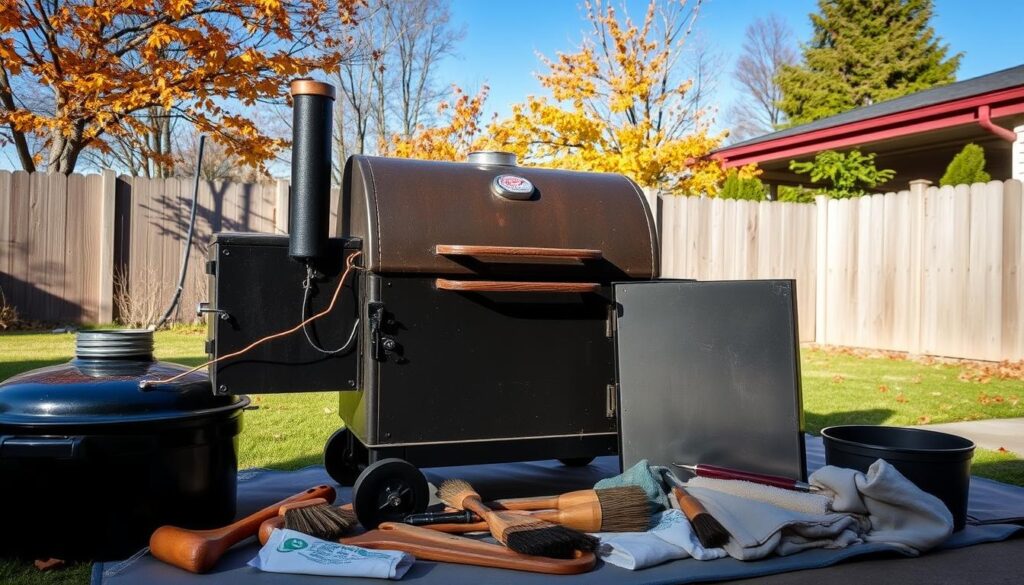
Storing and maintaining your smoker properly is crucial for its performance. By following these easy steps, you’ll keep your smoker in great shape. This way, it will be ready to give you tasty, smoky food for many barbecues to come.
Tips for Keeping Your Smoker Clean
Keeping your smoker clean is key to making tasty barbecue. There are easy tips to help you keep your smoker in great shape. By using smart cleaning methods, your smoker will always be ready for delicious smoked meats and veggies.
Using Foil Liners and Pans
Using foil liners and pans is a great way to keep your smoker clean. Cover drip pans and heat deflectors with heavy-duty aluminum foil. This catches drips and residues, making cleanup easy. Always replace the foil to keep your smoker clean and ready for use.
Cleaning as You Cook
Clean your smoker as you cook to keep it in top shape. Check the inside during long smoking sessions and remove ash or debris. This stops residues from building up and affecting your food’s flavor. Use a shop vacuum to quickly clean out ash while the smoker is hot, safely.
Follow these easy tips to keep your smoker clean and make great barbecue every time. A well-kept smoker is essential for amazing barbecue. So, always focus on keeping smoker clean with foil in your smoking routine.
Conclusion
Keeping your smoker clean and well-maintained is key to getting the best results. This guide has shared the best ways to clean, season, and care for your smoker. By doing so, you can make your smoker last longer and always get tasty, high-quality smoked dishes.
Putting in the effort to maintain your smoker well will really pay off. It ensures your smoker works great and gives you delicious, smoky flavors every time. A clean smoker is crucial for making top-notch smoked foods that will wow your guests.
This article has given you a detailed look at how to clean and maintain your smoker right. By using these tips, you’ll keep your smoker in great shape. This means better performance and amazing flavors from smoked meats, fish, and veggies.
FAQ
Why is it important to clean and maintain my smoker?
Cleaning and maintaining your smoker is key for great results every time. It stops ashes, grease, and other stuff from messing with your food’s flavor and quality. Regular care also keeps your smoker working well and makes it last longer.
What are the essential steps for routine cleaning after each use?
Start by heating your smoker to about 400°F. Then, use a steel wire brush to clean off any ash inside. Finish by wiping down the inside with a warm, damp cloth to get rid of food bits and sauces.
Why is seasoning my smoker important?
Seasoning your smoker makes the inside non-stick, like a cast-iron pan. This coating stops moisture and residues from sticking, keeping your smoked foods tasting great. Season it 2-3 times a year, or after a deep clean.
When should I perform a deep cleaning on my smoker?
Clean your smoker deeply every 6 months or a year, based on how often you use it. Look out for heavy grease, rust, or changes in how it works or tastes. That means it’s time for a deep clean.
How can I prevent rust and corrosion on my smoker?
Check for rust signs like color changes, pits, or flakes often. If you find rust, clean it off with a wire brush or sandpaper. Then, apply a high-heat resistant paint or sealant to protect it from rusting more.
How do I properly clean and maintain my smoker accessories?
Clean the cooking grates with a damp cloth or a grill scraper after each use. For a deeper clean, soak them in warm, soapy water or put them in the dishwasher. Keep the rubber gasket or seal around the smoker’s door or lid clean to keep smoke and temperature right.
What steps should I take to prepare my smoker for storage and bring it out of storage?
Clean the inside and outside of your smoker before storing, getting rid of ash, grease, and residues. Make sure it’s dry and clean the grates. Apply a thin layer of oil inside to stop rust. When you take it out, check for rust or damage, clean it, and re-season the inside before smoking again.
How to Avoid Common Pitfalls in BBQ Competitions
Are you a BBQ enthusiast ready to shine in competitions? Get your smoker ready and aim for the judges’ hearts. The BBQ competition world is exciting but tricky. This guide will help you dodge common mistakes and win big.
Key Takeaways
- Understand the specific competition rules and judging criteria to tailor your approach
- Hone your meat preparation, temperature control, and flavor balancing skills
- Develop a detailed competition plan to manage time, recipes, and setup effectively
- Invest in quality equipment and master temperature control techniques
- Craft winning rubs and sauces that showcase your unique culinary flair
- Refine your presentation and plating techniques to impress the judges
- Stay calm and focused on competition day to execute your plan flawlessly
Master the Fundamentals of Great BBQ
To make BBQ that wins awards, you need to know the basics well. This means picking the best meat, controlling the temperature and smoke, and mixing flavors and textures just right. These skills will make your BBQ stand out and impress even the toughest judges.
Use the Best Cuts of Meat
Choosing top-quality meat is key in smoking. Go for the best cuts like brisket, pork shoulder, and ribs for tender, juicy, and tasty results. Learn how each cut reacts to different cooking and seasonings.
Monitor Temperature and Smoke
Keeping the temperature right is crucial for perfect BBQ. Use good thermometers and keep the temperature steady. Adjust the smoke by changing the airflow and wood chips for the best flavor.
Balance Flavors and Textures
Creating great BBQ rubs and marinades takes skill. Try different spices and herbs to find the perfect mix. Focus on sweet, savory, and smoky tastes, and make sure the meat is both tender and crispy.
| Smoking Meat Techniques | Temperature Control in BBQ | BBQ Rub and Marinade Recipes |
|---|---|---|
| – Select high-quality cuts of meat – Understand the properties of each cut – Experiment with different smoking methods |
– Invest in reliable thermometers – Maintain consistent temperature – Manage smoke levels effectively |
– Create a balanced blend of spices and herbs – Experiment with sweet, savory, and smoky flavors – Achieve the perfect texture contrast |
“The secret to great BBQ lies in the fundamentals. Master the basics, and the rest will fall into place.”
Thoroughly Understand the Rules
In BBQ competitions, “the devil is in the details” is very true. Not paying attention to the rules can lead to disqualification. This can ruin your chance to win. As someone who wants to be a BBQ champion, it’s key to read and understand the rules well.
Knowing the rules well can help you win, as you can plan better. You’ll learn about BBQ judging criteria and food safety in BBQ competitions. This knowledge gives you an edge over others.
- Carefully review the competition’s guidelines and scoring criteria.
- Understand the specific requirements for each category, such as meat type, cooking methods, and presentation.
- Ensure that your recipes, preparation techniques, and food handling practices comply with the rules and regulations.
- Pay close attention to the submission deadlines, turn-in times, and any other logistical details.
- Consult with experienced competitors or the organizers if you have any questions or need clarification.
Even a small mistake can have big consequences. So, make sure you know all the rules. This way, you’ll have a better chance of winning and won’t get disqualified.
“Winning a BBQ competition is about more than just great-tasting food. It’s about understanding and executing the rules to perfection.”
Success in BBQ competitions isn’t just about smoking and grilling well. It’s also about knowing and following the rules. By doing this, you’ll have a good chance at the grand prize.
Perfecting Your Competition Plan
Winning at BBQ competitions takes a lot of planning and hard work. It’s important to know how to make a winning plan. This guide will help you get ready for the big competition.
Practice Your Recipes and Techniques
Being consistent is key in BBQ contests. Spend a lot of time making your recipes better and improving your cooking skills. Try out different smoking woods and flavors to find what works best for you. Practice your whole competition menu often to see where you can get better.
Time Management and Scheduling
Managing your time well is crucial in a BBQ competition. Make a detailed plan for every step, from getting ready to serving. Make sure to leave enough time for each task, including unexpected delays or problems with your gear. Staying on schedule helps you do your best and keeps you calm when the judges are watching.
| Task | Time Allocation |
|---|---|
| Meat Preparation | 2 hours |
| Seasoning and Rubs | 30 minutes |
| Smoking and Cooking | 6-8 hours |
| Sauce and Sauce Application | 1 hour |
| Plating and Presentation | 30 minutes |
By getting good at BBQ competition strategies and putting in the time and effort, you’ll improve your competition plan. You’ll be able to make amazing dishes for the competition.
Common BBQ Competition Mistakes to Avoid
Competing in a BBQ contest is thrilling and rewarding, but it’s full of potential pitfalls. Knowing the common mistakes can help you avoid them. It’s key to understand the BBQ judging criteria set by the event organizers.
Ignoring the BBQ judging criteria is a big mistake. Not following these rules can lead to losing points or even being disqualified. Make sure to read the rules carefully to ensure your dishes are up to par.
Another mistake is overlooking the basics of great barbecue. Even creative recipes can fail if you ignore the basics. Use the best meat, control the temperature well, and balance the flavors and textures.
| Common Pitfalls | Potential Consequences |
|---|---|
| Ignoring BBQ Judging Criteria | Points deducted or disqualification |
| Neglecting Fundamentals of Great Barbecue | Subpar dish quality and lower scores |
| Lack of Preparation and Practice | Inconsistent or underperforming dishes |
| Failing to Manage Time and Schedule | Missed deadlines and rushed presentation |
Preparation is crucial. Practice your recipes and techniques before the competition. Consistent execution is key in a competition. Also, managing your time well is important to present your dishes perfectly.
By avoiding these common mistakes, you’ll improve your chances of winning. Stay focused, follow the rules, and trust your barbecue skills. The judges will notice your hard work.
Selecting the Right Equipment
In the world of BBQ competitions, having the right equipment is key. It’s not just about the tools; it’s about how they help you win. Quality smokers and grills, along with perfect temperature control, can make your BBQ stand out.
Investing in Quality Smokers and Grills
Your smoker or grill is more than just a tool; it’s a part of your BBQ skill. Choose high-quality equipment that gives you the right temperature and smoke for your dishes. Look for features like precise temperature control, even heat, and durability. This ensures your gear can handle the competition demands.
Temperature Control Mastery
- Understand the ideal temperature ranges for different cuts of meat and cooking methods.
- Learn how to manage airflow and fuel to maintain precise temperature control throughout the cooking process.
- Experiment with different wood chips and charcoal types to find the perfect smoke and heat.
- Invest in a reliable digital thermometer to closely monitor the internal temperature of your meats.
With the right equipment and temperature control skills, you’re on your way to making BBQ that wins competitions. Remember, the tools you pick and how you use them can change the game. Choose wisely and practice a lot.
“The key to winning a BBQ competition is not just the quality of your meat, but the precision of your equipment and temperature control.”
Crafting Winning Rubs and Sauces
To take your BBQ to the next level, learn how to make tasty rubs and sauces. These are key to a winning dish. We’ll show you simple dry rub recipes and how to make sauces that will wow BBQ judges.
Simple and Balanced Dry Rub Recipes
A great dry rub is essential for top BBQ. It should balance flavors so your meat’s natural taste comes through. Here are two rub recipes that will boost your BBQ:
- Classic Steak Rub: Brown sugar, paprika, garlic powder, onion powder, black pepper, and a pinch of cayenne pepper.
- Smoky Pork Rub: Smoked paprika, brown sugar, chili powder, cumin, mustard powder, and a touch of cinnamon.
Be sure to rub these on generously for the best flavor.
Complementary Sauce Varieties
The right sauces can elevate your BBQ. Try different flavors like sweet, tangy, smoky, or spicy. Here are some ideas:
- Honey Bourbon Barbecue Sauce: Sweet and savory, great for ribs or pulled pork.
- Spicy Mustard Glaze: Zingy and vibrant, perfect for chicken or brisket.
- Tropical Mango Salsa: Refreshing and fruity, great for smoked or grilled seafood.
Find the right flavor balance to enhance your meats. With some trial and attention to detail, you’ll make BBQ dishes that win.
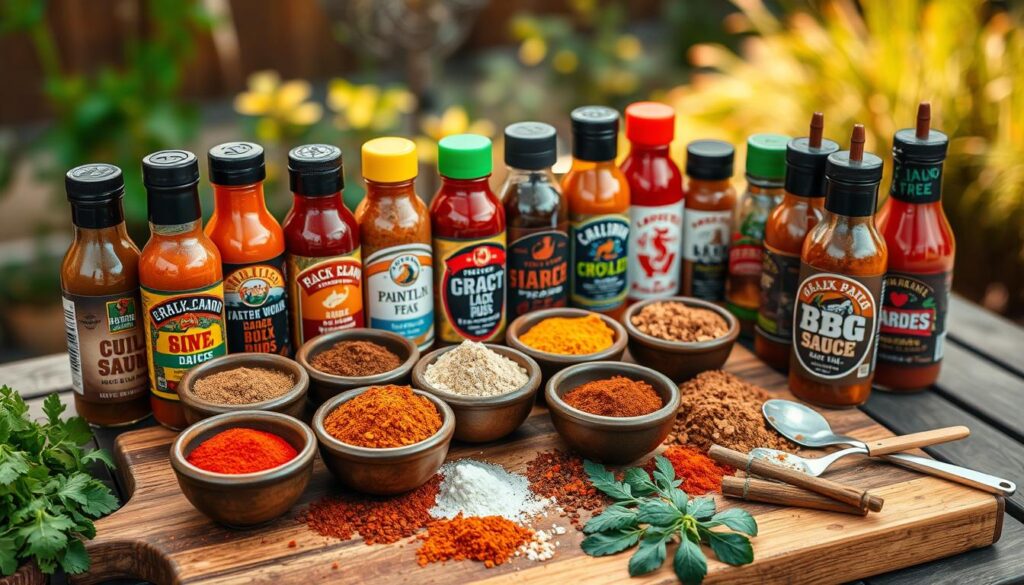
“The secret to great BBQ is in the details. Perfect your rubs and sauces, and you’ll be well on your way to competition-worthy dishes.”
Presentation and Plating Techniques
In BBQ competitions, how you present your food is as important as the taste. The way you arrange and garnish your dishes can make the difference between winning and losing. Learning to present your BBQ perfectly is key to doing well.
When it comes to BBQ presentation, focus on making your plates look great. Think about the colors, textures, and how everything fits together. Curly parsley, lettuce discs, and kale are good garnishes, but use them wisely. They should highlight your delicious smoked meat.
- Arrange your meat carefully, making sure it looks neat and even.
- Use different colors and textures to make your plate stand out.
- Don’t overdo it with the garnishes, let your BBQ speak for itself.
- Keep your plating consistent across all dishes, as judges will be checking.
| Garnish | Pros | Cons |
|---|---|---|
| Curly Parsley | Vibrant green color, adds texture | Potential to overpower the meat flavor |
| Lettuce Discs | Clean, refreshing appearance | Can look plain if not executed properly |
| Kale | Earthy tones, adds visual interest | Requires careful trimming and placement |
Your goal in BBQ competitions is to make a plate that looks stunning and shows off your meat’s true flavor. By following these presentation tips for BBQ dishes, you’ll impress the judges and maybe even win the trophy.
“Perfection is not just about the taste – it’s about the entire experience. Captivating presentation can elevate an already exceptional BBQ dish to greatness.”
Preparing for the Competition Day
BBQ competitions can be nerve-wracking, but with the right prep, you can stay calm and enjoy it. We’ll give you checklists and tips to make your competition day smooth and focused. This way, you can perform your best.
Packing and Setup Checklists
Planning and organizing are crucial for a smooth competition day. Create a detailed packing list to avoid missing important supplies or equipment. Make sure to include:
- BBQ tools and utensils
- Meat thermometers and probes
- Rubs, sauces, and marinades
- Coolers and ice for food storage
- Setup materials like tables, chairs, and canopy
- Personal items like water, snacks, and sunscreen
When you arrive, have a setup plan to arrange your space efficiently. This keeps you calm and focused.
Staying Calm and Having Fun
BBQ contests can be intense, but remember to enjoy it. Practice relaxation techniques like deep breathing and visualization to keep stress low. Have a supportive team and take breaks to recharge.
The heart of BBQ competitions is about friendship, creativity, and passion. Connect with others, learn from them, and share your unique style and flavors. Stay positive and focused to perform well and have fun.
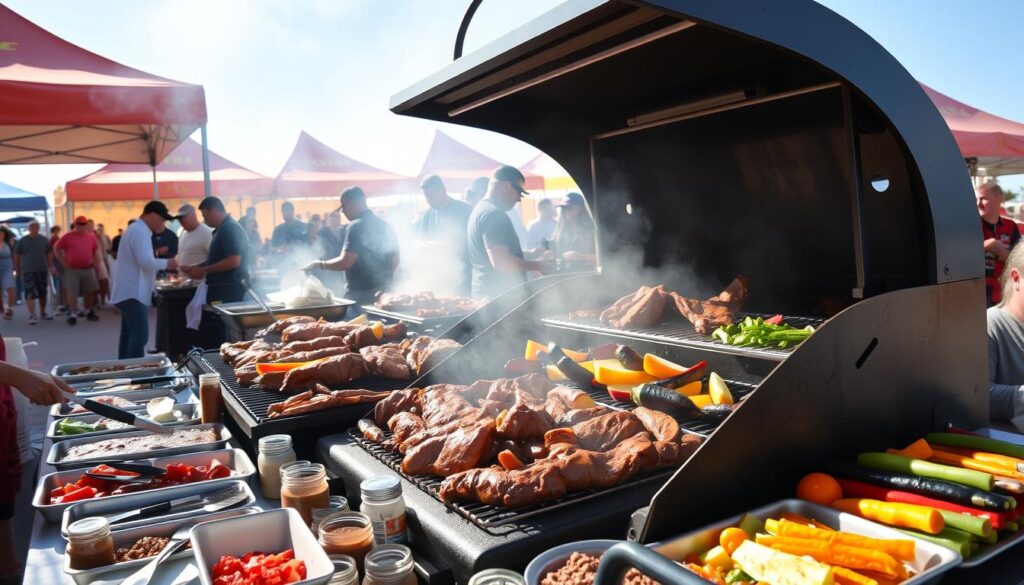
“The true secret to success in BBQ competitions is not just mastering the techniques, but also maintaining a positive mindset and enjoying the journey.” – Pitmaster John Smith
Conclusion
Starting your BBQ competition journey is exciting and rewarding. Mastering the basics and knowing the rules helps you make dishes that wow the judges. Avoiding BBQ competition mistakes is key to success.
Improving your BBQ judging criteria and BBQ competition strategies will help you stand out. With hard work, creativity, and a bit of magic, you’ll take your BBQ to new levels. You’ll impress judges and competitors alike.
Winning a BBQ competition is about more than just great food. It’s about adapting, being creative, and having fun. Enjoy the company, the thrill, and every moment as you aim for the top. Best of luck on your BBQ journey.
FAQ
What are the key fundamentals of great BBQ that I need to master?
To improve your BBQ skills, focus on using top-quality meat. Keep a close eye on temperature and smoke levels. Also, aim for a mix of flavors and textures that work well together.
Why is it so important to thoroughly understand the competition rules?
Not knowing the competition rules can lead to being disqualified. Understanding them well boosts your chances of winning. It also helps you avoid mistakes.
How can I develop a comprehensive strategy to ensure I’m fully prepared for the competition day?
Preparation is key for BBQ success. Work on your recipes and techniques. Also, manage your time well to be ready for the competition.
What are some of the most common pitfalls that plague BBQ competitors?
Common mistakes include ignoring the rules and overlooking basic barbecue skills. Being aware of these errors helps you stay focused and competitive.
How can I choose the right equipment and optimize its performance for competition-level results?
Invest in quality smokers and grills. Learn how to control temperatures well. Choose the right tools and use them effectively for top results.
What are some expert-approved dry rub recipes and how can I create complementary sauce varieties?
Rubs and sauces are key to great BBQ. Learn expert-approved recipes and how to make sauces that match your meats well.
How can I elevate my presentation skills to impress the judges?
Good presentation can make a big difference in BBQ contests. Learn how to plate your food well and make it look appealing to judges.
What tips can help me maintain a positive mindset and enjoy the competition day experience?
The competition day can be stressful, but you can stay calm and enjoy it. Use checklists and tips to stay focused and positive.
Managing Time and Temperature for BBQ Competition Success
Ever wondered what makes BBQ champions stand out? It’s all about controlling time and temperature. Grilling is fun, but competition BBQ requires a deep knowledge of fire, smoke, and slow-cooked perfection.
In BBQ competitions, seconds and degrees matter a lot. They can turn a winning dish into a forgettable one. But don’t worry, this guide will give you the skills to master time and temperature. You’ll be able to take your BBQ skills to the next level and shine in tough competitions.
Key Takeaways
- Understand the fundamental differences between barbecuing and grilling to master the art of low-and-slow cooking.
- Discover the origins and evolution of barbecue as a culinary tradition across the United States.
- Explore the crucial role of temperature control in achieving competition-worthy results with your meats.
- Learn effective strategies for managing multiple smokers and temperature zones to optimize your cooking process.
- Unlock the secrets of time management and advance preparation to excel in the time-constrained environment of BBQ competitions.
Understanding Barbecuing and Grilling
For BBQ lovers, knowing the difference between barbecuing and grilling is key. These terms are often mixed up, but they mean different cooking methods. Each method gives unique results.
The Difference Between Barbecuing and Grilling
Barbecuing cooks meat, fish, and veggies slowly at a low temperature, between 95 and 120 degrees Celsius. This slow cooking lets flavors blend together, making dishes tender and full of taste. On the other hand, grilling cooks food quickly over high heat, between 180 to 350 degrees Celsius. Food is cooked right above the flames or embers.
The Origins of Barbecue
The word “barbecue” comes from the 16th-century Mexican term “barbacoa,” meaning slow-cooking meat in a pit. Over time, barbecue has grown, with each region adding its own twist. From Texas’s smoky flavors to the Carolinas’ tangy sauces, barbecue is a rich tradition.
“Barbecuing is not just a cooking method; it’s a way of life, a celebration of community, and a testament to the power of patience and perfect timing.” – Pitmaster Joe Pearce
Whether you’re a BBQ pro or just starting, knowing the basics of barbecuing and grilling is crucial. It’s the first step to becoming a master of true BBQ.
Mastering Fire and Temperature Control
Being able to control the temperature in your smoker or grill is key to great barbecuing. As a pitmaster, learning how to manage fire and temperature is vital for top-notch results. Let’s look at why temperature matters in barbecuing and how to get it right for perfect cooking.
The Importance of Temperature in Barbecuing
Temperature makes barbecue magic happen. It makes meat tender, adds smoky flavors, and caramelizes the outside. Keeping a steady temperature is crucial for consistent dishes, whether it’s ribs, brisket, or pulled pork. If the temperature changes, meat can dry out or not cook enough.
Managing temperature in a smoker with charcoal or wood is tricky. The type of fuel and airflow control the temperature. By adjusting the dampers, you can change the oxygen flow and the smoker’s temperature.
| Temperature Range | Ideal for Cooking |
|---|---|
| 225°F – 250°F | Low and slow cooking of brisket, pork shoulder, and ribs |
| 300°F – 350°F | Grilling steaks, burgers, and other quick-cooking meats |
| 400°F – 450°F | High-heat searing and caramelization of the exterior |
Keeping a steady temperature is key for top barbecue results. By getting the hang of fire and temperature control, you’ll make delicious, award-winning dishes.
“Temperature control is the foundation of exceptional barbecue. It’s the difference between a tough, dry brisket and a tender, juicy masterpiece.”
Preparing Meats for Competition-Level Barbecuing
For top-notch barbecuing, the meat you pick is key. Pitmasters stress the need for selecting high-quality cuts of meat. This choice is crucial for a great dish, from tender briskets to tasty ribs.
Selecting High-Quality Cuts of Meat
Choose meats that are well-marbled and have a good fat-to-lean mix. This keeps the meat juicy and tender during slow cooking. Stay away from meats with too much connective tissue, as they can become tough.
Marinating and Seasoning Techniques
For top barbecuing, marinating and seasoning techniques are vital. Pitmasters warn against oiling the meat before grilling. Instead, use marinades that soak into the meat and boost its flavor.
Be careful with dry spice mixes on the grill or smoker. The heat can burn the spices, making them taste bitter. Season the meat after cooking, during the resting phase, for the best flavor.
“The key to competition-level barbecuing is understanding the nuances of meat selection, marinating, and seasoning. With the right techniques, you can elevate your backyard grilling to new heights.”
Time and Temperature for BBQ Competitions
In competitive barbecue, getting it right is crucial. Knowing the best cooking temperatures for meats is key to winning. Whether you’re grilling steaks or slow-smoking briskets, the right internal temperatures are vital for top scores.
Optimal Cooking Temperatures for Different Meats
Here are the best cooking temperatures for meats in BBQ contests:
- Beef Brisket: 195°F to 205°F (91°C to 96°C)
- Pulled Pork: 195°F to 205°F (91°C to 96°C)
- Chicken: 165°F to 175°F (74°C to 79°C)
- Ribs: 195°F to 205°F (91°C to 96°C)
- Sausage: 160°F to 165°F (71°C to 74°C)
Reaching these temperatures makes sure the meat is just right. It’s tender and full of flavor, just what judges want.
Precision Temperature Monitoring with Digital Thermometers
For top BBQ results, it’s all about precise temperature control. Digital thermometers with probes are a must. They let you track the meat’s internal temperature closely. This way, you can adjust the heat or airflow to keep the meat at the perfect temperature.

“Precision temperature monitoring is the secret weapon of top BBQ competitors. It’s the difference between a good meal and a Grand Champion-worthy dish.”
Managing Multiple Smokers and Temperature Zones
Cooking for a BBQ competition means handling multiple smokers and temperature zones at once. This can seem tough, but with the right tools and strategies, you can keep a tight grip on your cooking environment.
Using Billows BBQ Control Fans for Temperature Regulation
The Billows BBQ control fan is a great tool for managing temperature in charcoal and wood-fired smokers. These fans automatically feed air to the smoker when the temperature drops below your set range. They slow or stop the air flow when it gets too high. This keeps your cooking steady and consistent, even when you’re working with several smokers and temperature zones.
- Precise temperature control for consistent results
- Automated air flow regulation to maintain optimal cooking conditions
- Compatibility with a wide range of smoker and grill models
Using Billows BBQ control fans removes the guesswork from temperature management. You can focus on perfecting your BBQ recipes. This technology lets you easily keep the perfect cooking environment, even with multiple smokers and temperature zones.
“The Billows fan has been a game-changer for my BBQ competitions. It takes the stress out of temperature control and allows me to devote my attention to crafting the perfect smoked meats.”
Controlling Temperature in Charcoal and Wood-Fired Smokers
Learning how to control the temperature in charcoal and wood-fired smokers is key to winning at barbecue. It’s all about knowing how to adjust airflow and vents, and how to manage the fuel during cooking.
Understanding Airflow and Vent Adjustments
The intake damper controls how much oxygen goes into the smoker. The exhaust damper lets out the gases and extra heat. Getting these vents right is vital for keeping the right cooking temperature. By adjusting the airflow, you can make sure your smoker stays at the perfect temperature for your food.
Fuel Management: Adding Charcoal or Wood During Cooking
Adding more charcoal or wood at the right time can greatly improve temperature control. Keep an eye on the fuel levels and add more as needed. This keeps the temperature steady and prevents your meat from getting ruined.
Mastering temperature control in smokers will help you make delicious barbecue that wins awards. Always pay attention and keep the temperature just right. Your smoker will be your best ally.
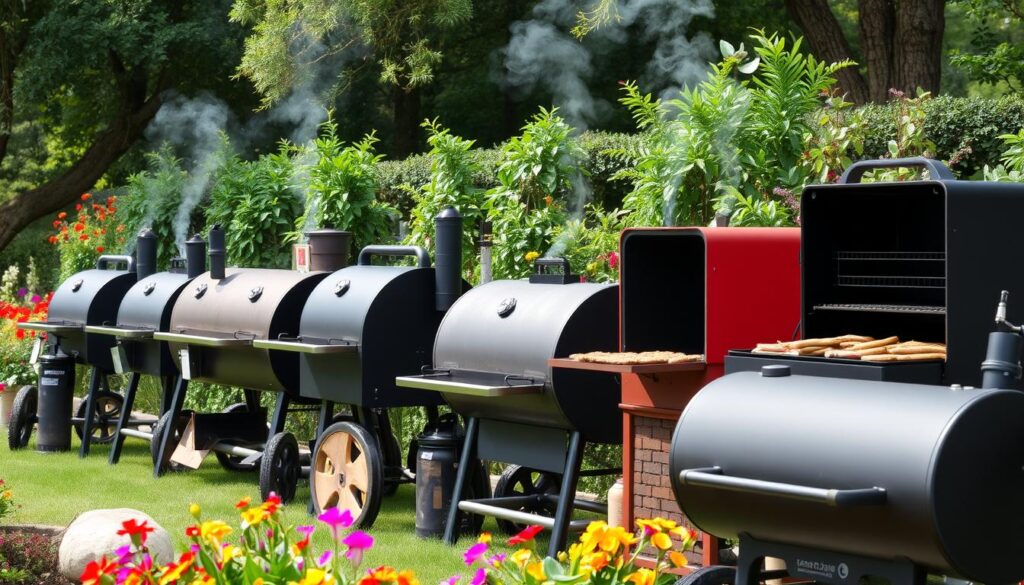
“The secret to competition-level barbecue is in the details – and that includes precise temperature management.”
Effective Time Utilization in BBQ Competitions
BBQ competitions require careful time management. Pitmasters know the value of planning and preparation. They use strategies like serving appetizers and side dishes to buy time while the main dishes cook.
Planning and Preparation Strategies
Top BBQ teams put a lot of work into planning and preparing. They might:
- Look over past competition notes to find ways to get better
- Try out new cooking methods and flavors
- Use feedback from past events to improve their recipes
- Make a detailed BBQ checklist to not miss anything important
Serving Appetizers and Side Dishes to Buy Time
Pitmasters know that serving appetizers and side dishes helps them buy time in competitions. These dishes keep judges and spectators happy while the main dishes cook. This way, pitmasters can focus on their cooking without rushing or sacrificing quality.
| Appetizer | Estimated Cooking Time |
|---|---|
| Grilled Shrimp Skewers | 15-20 minutes |
| Smoked Chicken Wings | 30-40 minutes |
| Bacon-Wrapped Jalapeño Poppers | 20-25 minutes |
“Effective time management is the key to success in BBQ competitions. By serving appetizers and side dishes, we can keep our guests satisfied while the main meats continue to cook to perfection.”
Mastering effective time utilization is what sets winners apart in BBQ competitions. By planning well and serving extra dishes, pitmasters make sure their meats get the time they need. This approach helps them impress judges and win the competition.
Using Combi-Steamers for Grilling and Smoking
The world of barbecue and grilling is always changing. Chefs and pitmasters are finding new tools and techniques to improve their skills. Combi-steamers are becoming popular for their precision and versatility in smoking and grilling meats.
Sous-Vide and Low-Temperature Smoking with Combi-Steamers
Combi-steamers are great for low-temperature smoking, similar to traditional barbecue. They keep the temperature and humidity just right. This lets you cook meats that are tender and full of smoky flavor.
Using the sous-vide feature, you can get consistent results every time. This is very important in BBQ competitions where you need to impress judges.
Grilling Accessories for Combi-Steamers
Combi-steamers are not just for smoking. They also work well for grilling with special accessories. You can get grill plates and sear grates that help create the perfect sear on your meats.
With these accessories and the combi-steamer’s precise temperature control, your grilled meats will look amazing. They’ll impress even the toughest judges.
FAQ
What are the main differences between barbecuing and grilling?
Barbecuing cooks meat, fish, and veggies slowly at a low temperature, between 95 and 120 degrees Celsius. Grilling, on the other hand, cooks at a hotter temperature of 180 to 350 degrees right above the flames or embers.
Where does the term “barbecue” come from?
The word “barbecue” comes from the Mexican term “barbacoa.” It was used in the 16th century to describe cooking meat slowly in a covered pit.
Why is controlling the temperature in a charcoal or wood-fired smoker crucial for successful barbecuing?
Keeping the right temperature in a smoker is key for great barbecuing. The type of fuel and airflow control the temperature. By adjusting the dampers, you can manage the oxygen flow and keep the smoker at the right temperature.
What are the best practices for preparing meats for competition-level barbecuing?
For top-level barbecuing, pick the best meat cuts and marinate them right. Experts say don’t oil the meat before grilling. Also, avoid dry spice mixes to prevent a bitter taste from burning.
What is the importance of using a core temperature probe in BBQ competitions?
Using a core temperature probe is vital in BBQ contests. It helps keep meats at the perfect doneness. This tool ensures consistent results in competitive barbecuing.
How can the Billows BBQ control fan help regulate the temperature in charcoal and wood-fired smokers?
The Billows BBQ control fan helps by adding air to the smoker when it’s too cool and reducing air when it’s too hot. This keeps the temperature steady for even cooking.
What are the key factors to consider when controlling the temperature in charcoal and wood-fired smokers?
To control smoker temperatures, focus on airflow and vent management. The intake damper controls oxygen, and the exhaust damper lets out gases and heat. Adjusting airflow and adding fuel as needed keeps temperatures consistent.
How can effective time management be achieved in BBQ competitions?
Good time management is key in BBQ contests. Plan your cooking and serve side dishes early to keep guests happy while the main dishes cook.
How can combi-steamers be used for grilling and smoking meats in competition-level barbecue?
Combi-steamers are great for grilling and smoking meats at low temperatures. They offer precise temperature control and sous-vide capabilities. This makes them a valuable tool for consistent results in competitive BBQ.
How to Use a Meat Thermometer for Perfect Results in BBQ Competitions
Are you a pitmaster aiming to top the competition circuit? Mastering temperature control is key in grilling and smoking meats. While texture, color, and firmness hint at doneness, a meat thermometer is the only sure way to know your meats are perfect. But, it’s not just about sticking it in and waiting. There’s an art to using these tools for top-notch BBQ. Ready to elevate your grilling skills and wow the judges?
Key Takeaways
- A meat thermometer is crucial for achieving the perfect internal temperature for competition-worthy BBQ
- Proper probe placement and technique are essential for accurate temperature readings
- Calibrating your thermometer ensures consistent, reliable results every time
- Wireless and Bluetooth-enabled thermometers offer convenient monitoring from a distance
- Mastering temperature control is the key to impressing BBQ competition judges
The Importance of Using a Meat Thermometer in BBQ Competitions
In BBQ competitions, a meat thermometer is key. It makes sure your food is safe to eat and helps you get that perfect competition-level doneness. This is crucial for success.
Safety: Ensuring Proper Internal Temperatures for Safe Consumption
Food safety is always first in barbecue. If meats are not cooked enough, they can make people sick. A precise grill thermometer lets you check if your competition brisket is safe to eat. This keeps you and your guests safe.
Consistency: Achieving Desired Doneness Every Time
The competition BBQ grill can be tricky, with hot spots and changing temperatures. But a barbecue temperature gauge helps you know the exact temperature of your meat. This means you can take it off the grill just when it’s right, every time. No more surprises or letdowns.
“Using a meat thermometer takes the mystery out of grilling and smoking. It’s the key to unlocking perfect doneness every single time.”
Whether you’re going for the top prize or just want to wow your friends, a meat thermometer is a must-have. Learn how to use it well, and you’ll be on your way to grilling success.
Preparing Your Meat Thermometer for Competition
As a pitmaster, your meat thermometer is key to making delicious BBQ. It’s vital whether you’re using a professional smoker thermometer or a BBQ contest meat probe. Make sure it’s ready for accurate temperature readings at your BBQ competitions.
Calibrating Your Thermometer for Accurate Readings
Before the competition, calibrate your meat thermometer for BBQ competitions for reliable readings. Put the thermometer tip in ice water and check it shows 32°F (0°C). If it doesn’t, adjust it as the maker suggests for accurate competition brisket thermometer readings.
Choosing the Right Thermometer Type for Your Needs
- Instant-read thermometers: Great for quick checks during cooking.
- Probe thermometers: Ideal for tracking internal temps from start to finish, with alarms for when your meat is done.
- Wireless/Bluetooth thermometers: Let you monitor temperatures from afar, so you don’t have to keep opening the smoker.
Choose a thermometer that fits your BBQ competition needs. Your pitmaster thermometer is crucial for perfectly cooked meats every time.
“The key to winning BBQ competitions is all in the details. Properly calibrating and using your meat thermometer is essential for achieving that award-winning tenderness and flavor.”
Meat thermometer for BBQ competitions
For BBQ competitions, a meat thermometer is key. It’s vital whether you’re competing in a competition BBQ grill or trying to impress with your competition brisket. A barbecue temperature gauge helps you win.
Digital grill thermometers are a big step up from analog ones. They’re fast and show clear numbers. No more guessing with a meat thermometer for BBQ competitions. You get quick, accurate readings to make winning choices.
These thermometers are also safer than old mercury ones. They don’t have toxic substances, so you’re safe from leaks or spills.
Choosing the right precise grill thermometer is important. Whether you want a wireless one or a simple instant-read, the right meat thermometer for BBQ competitions leads to great results.
Techniques for Accurate Temperature Measurement
Getting the perfect temperature in your BBQ is key to winning. Learning how to use a precise grill thermometer is essential. It helps you make brisket and other smoked meats that are top-notch. Here are some tips to make you a pro at reading temperatures.
Proper Probe Insertion and Placement
First, take the meat off the grill before checking the temperature. This stops the heat of the grill from giving you wrong readings. Put the thermometer probe into the meat’s thickest part, like the center.
Avoid touching the bone, fat, or gristle with the probe. These can mess up your temperature readings.
Accounting for Carryover Cooking
After you take your meat off the grill, its temperature keeps rising. This is called carryover cooking. It’s important to know this as a pitmaster.
Wait at least 10 seconds before you call it done. The meat will keep cooking a bit during the rest time. This means your final temperature will be a bit higher than your last check.
| Technique | Description | Benefit |
|---|---|---|
| Proper Probe Insertion | Insert the thermometer probe into the thickest part of the meat, avoiding bone, fat, and gristle. | Ensures an accurate internal temperature reading for your competition BBQ grill. |
| Accounting for Carryover Cooking | Wait 10 seconds after removing the meat from the grill before taking the final temperature reading. | Prevents underestimating the final internal temperature due to the meat’s continued cooking. |
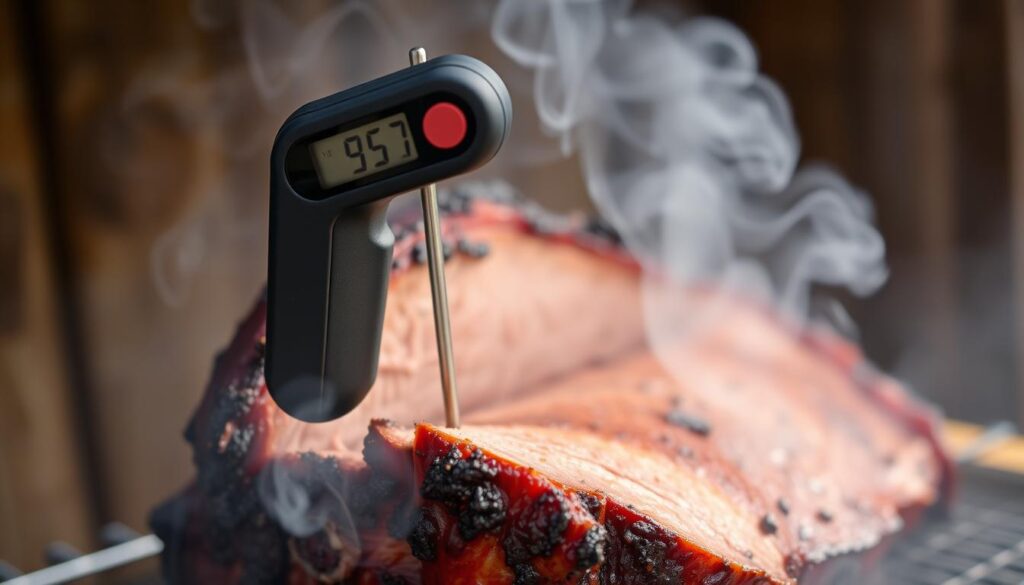
Master these techniques for accurate temperature reading, and you’ll be a pro at BBQ. Keeping a close eye on the temperature is what takes your BBQ to the next level. It’s how you impress the judges and win.
Understanding Internal Temperature Ranges
Mastering BBQ competitions means being precise and paying attention to details. Knowing the right internal temperatures for different meats is key. Whether you’re an expert with a competition brisket thermometer or just starting with a pitmaster thermometer, getting the temperature right is crucial. It can make the difference between winning and losing.
The safe minimum internal temperature for poultry is 165°F, checked with a professional smoker thermometer. This kills harmful bacteria, making the meat safe to eat. For beef, aim for 130-135°F for medium-rare and 150-155°F for medium-well.
| Meat Type | Ideal Internal Temperature |
|---|---|
| Poultry | 165°F |
| Beef (Medium-Rare) | 130-135°F |
| Beef (Medium-Well) | 150-155°F |
Checking the internal temperature of your meats is vital for safety and perfect cooking. A trusted competition brisket thermometer, pitmaster thermometer, or professional smoker thermometer helps you cook without guessing. This way, you’ll always serve delicious food that wows judges and BBQ fans alike.
“The secret to great BBQ is all in the temperature. If you can nail that, the rest is just gravy.”
Wireless and Bluetooth Meat Thermometers
In the world of BBQ competitions, tools like the professional smoker thermometer are key. They help ensure your meat is cooked just right. The latest innovation is the bluetooth meat thermometer.
Continuous Monitoring from a Distance
A wireless meat thermometer lets you check your meat’s temperature from afar. Just put the probes in the meat and leave them cooking. This way, you can keep an eye on your meat’s progress. It makes sure your meat is cooked to perfection every time.
Integration with Smartphone Apps
Now, many wireless thermometers work with smartphone apps. These apps let you set temperature alerts and track multiple probes at once. You’ll also get notified when your meat is done. This means you can focus on other things while your thermometer keeps an eye on your meat.
Using wireless and bluetooth meat thermometers can really change the game for you in BBQ competitions. They help you prepare meat better, ensuring it’s always safe, consistent, and delicious.
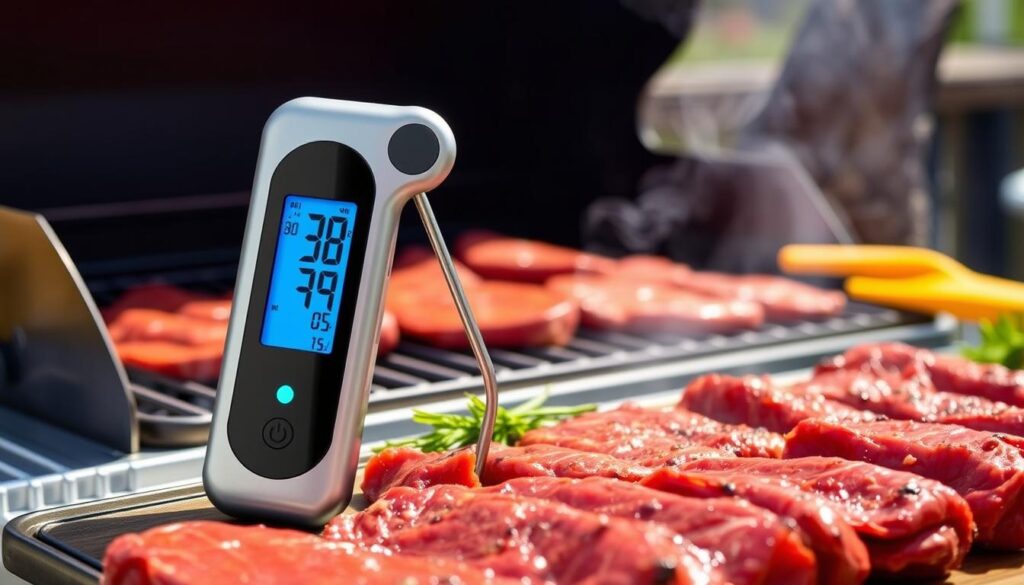
Preparing for Competition Day
As the big competition day gets closer, make sure you’re ready to give your best. Get your equipment and supplies in order and plan your cooks for the best timing. Every little thing matters when you’re competing for the top prize.
Organizing Your Equipment and Supplies
First, check over your BBQ grill, temperature gauge, and other important tools. Make sure they’re clean and ready to work perfectly. Then, arrange your supplies like marinades, rubs, garnishes, and platters so they’re easy to find.
Timing Your Cooks for Maximum Efficiency
Timing is everything in BBQ competitions. Even a small delay can affect your score. Use your pitmaster thermometer to check meat temperatures. Plan your cooking so there’s enough time for resting and any final touches.
Being well-prepared is the secret to doing great in competitions. By organizing your gear and getting your cooking timing right, you’re on your way to a winning performance.
Tips for Presentation and Garnishing
As you finish your competition BBQ grill dish, think about how you’ll present it. A well-cooked, seasoned piece of meat is great, but how you show it off matters a lot. It can make a big difference in how the judges see your dish.
Keeping Garnishes Fresh and Hydrated
Garnishes are key to making your dish look great. Keep them fresh and bright by using damp paper towels. This stops them from wilting and losing color. Use an insulated bag to keep your garnishes warm during the trip to the competition, especially if it’s cold.
Last-Minute Touch-Ups and Plating
When you’re plating your competition brisket thermometer-checked meat, have curved tweezers ready. They’re perfect for arranging garnishes and making your dish look its best. Be careful with how you place everything on the plate, thinking about how it looks together.
The pitmaster thermometer and professional smoker thermometer helped you cook the meat right. Now, add fresh garnishes and do some final touches to make your dish look ready for the competition.
Conclusion
Your journey to perfect BBQ dishes has shown how crucial a meat thermometer is. It ensures food is safe and consistent. It also helps you control temperatures precisely.
Using a classic or the latest wireless thermometers, a top-notch meat thermometer for BBQ competitions is key. It helps you reach the level of a pitmaster or professional smoker. With the right competition brisket thermometer or BBQ contest meat probe, you can keep an eye on your meats. Adjust your barbecue temperature gauge to get the perfect internal temperature every time.
As you get ready for your next BBQ competition, remember, winning isn’t just about your cooking skills. It’s also about mastering the right tools. With your reliable meat thermometer, you’re set to impress judges and win the trophy. This will make you a true king of the competition BBQ grill.
FAQ
Why is using a meat thermometer important for BBQ competitions?
A meat thermometer is key for food safety and perfect doneness in BBQ contests. It’s the best way to check the meat’s internal temperature. This ensures your meat isn’t too raw or too well done.
How do I calibrate my meat thermometer for accurate readings?
To calibrate your meat thermometer, fill a small container with ice water. Then, insert the thermometer’s tip and wait 20-30 seconds. The reading should be 32°F (0°C), water’s freezing point. Adjust your thermometer if the reading is wrong.
What are the ideal internal temperature ranges for different types of meat in BBQ competitions?
For best results, cook poultry to 165°F. Beef should be at 130-135°F for medium-rare and 150-155°F for medium-well. Keeping these temperatures ensures your meat is cooked right and safe to eat.
How can wireless and Bluetooth meat thermometers benefit me in BBQ competitions?
Wireless and Bluetooth thermometers let you check meat temperatures from afar. You don’t need to open the grill or smoker often. This helps keep your meat at the right temperature and prevents overcooking.
What other tips can help me prepare for a BBQ competition?
Use fresh and moist garnishes, and keep your meat warm in insulated bags. Also, have curved tweezers ready for plating. Good prep and organization will showcase your dish at its best to the judges.
Plating and Presentation Tips for BBQ Competitions
Are you ready to take your BBQ competition skills to the next level? The key to winning is in how you plate and present your food. In BBQ competitions, every detail matters. The way you present your dishes can be the difference between winning and losing.
Learn from our experts how to wow the judges and make your food look irresistible. We’ll cover everything from following the rules to using height and texture for a great look. This guide will give you the skills to improve your BBQ plating and presentation.
Key Takeaways
- Understand the importance of plating and presentation in BBQ competitions
- Learn how to create visual impact with height and strategic arrangement
- Discover the secrets to incorporating texture and contrast for craveable dishes
- Align your plating style with your restaurant’s theme and atmosphere
- Adhere to competition-specific guidelines for plating and presentation
The Importance of Plating and Presentation
In BBQ competitions, how you present your dishes matters a lot. Professor Charles Spence from Oxford found that presentation can make food taste better. People thought a salad looked like a painting tasted 29% better than the same salad without care for looks. They were even willing to pay three times more for it.
Good plating and presentation can make your BBQ look and taste better. This knowledge helps you make dishes that taste great and look amazing.
The Power of Presentation
Studies show that how a dish looks affects how good it tastes to judges. Things like color, texture, and arrangement make a dish look better. This can change how it’s judged.
- Color contrast: Using different colors makes your dishes stand out.
- Textural elements: Adding crunchy, creamy, or foamy bits makes eating more fun.
- Arrangement and height: Arranging things well and adding height makes your dish look more exciting.
Knowing about presentation can help you win BBQ competitions. The goal is to make dishes that taste great and look amazing.
“The way a dish is presented can make it taste up to 29% better, and diners are willing to pay up to 3 times more for a well-plated dish.”
– Professor Charles Spence, Oxford Psychologist
Understanding BBQ Competition Rules and Guidelines
Before you start plating your BBQ, get to know the rules from the sanctioning body. These rules tell you how to present your dishes, what garnishes you can use, and how to serve them.
The Mid Atlantic Barbecue Association (MABA) says garnishes are optional. But if you do use them, they must be fresh green lettuce, curly parsley, flat leaf parsley, curly green kale, or cilantro. You can’t use lettuce cores or other plants like endive or red-tipped lettuce. Breaking these garnish rules can cost you points.
Make sure you check the competition guidelines well. Not following them can lead to losing points or even getting disqualified. So, it’s important to know and follow the rules.
| Allowed Garnishes | Prohibited Garnishes |
|---|---|
|
|
Following the rules for plating and presentation is key to doing well in competitions. Not following them can lead to losing points or even getting disqualified. So, make sure to read the rules carefully and plan your dishes well.
Creating Visual Impact with Height and Arrangement
Chefs suggest adding height and strategic arrangement for visual interest on the plate. Start with a base, use ring molds, and fan or shingle meats for depth. This makes your BBQ competition dishes stand out.
Use vibrant leaves for salads and quenelles of ice cream or sorbet on desserts for height. Slicing meats on a bias highlights their quality and makes the presentation appealing.
Techniques to Add Dimension
- Build from the bottom up using ring molds
- Fan or shingle sliced meats to create depth
- Use vibrant leaves as a base for salads
- Place quenelles of ice cream or sorbet on top of desserts
- Slice meats on a bias and against the grain
These techniques can make your BBQ competition dishes look amazing. They add height and arrangement to make your food visually appealing. This way, your dishes will not only taste great but also show off your cooking skills.
| Technique | Description | Benefits |
|---|---|---|
| Building from the bottom up | Using ring molds to create a sturdy base | Adds depth and dimension to the plate |
| Fanning or shingling sliced meats | Arranging sliced meats in an overlapping pattern | Showcases the quality of the product and creates a visually appealing, layered presentation |
| Vibrant leaves as a bed for salads | Using colorful, fresh greens as a foundation | Adds a natural, eye-catching element to the dish |
| Quenelles of ice cream or sorbet | Crafting smooth, oval-shaped scoops of frozen desserts | Provides a textural contrast and creates height on the plate |
| Slicing meats on a bias | Cutting meats at an angle, rather than straight across | Showcases the quality of the product and creates an appealing, layered presentation |
Using these techniques can elevate your BBQ competition dishes. Thoughtful plating and presentation can greatly impact how your dishes are perceived. It can make them seem tastier and more valuable.
Texture and Contrast: Keys to Craveable Dishes
Chef Joyce Tang says mixing different textures like foams, sauces, and crunchy bits makes dishes more tempting. Using contrasting colors also boosts the look and feel of your food.
A vibrant vichyssoise can be a base for many dishes, and sweet sauces are great with desserts. Using seasonal ingredients like green asparagus and red strawberries adds to the dish’s appeal.
Incorporating Texture and Contrast
To make dishes more appealing, try these tips:
- Add foams for a light, airy feel.
- Use a mix of sauces, from creamy to tangy, for different tastes and textures.
- Include crunchy bits like toasted nuts or crispy breadcrumbs for texture.
| Texture | Example Ingredients | Benefits |
|---|---|---|
| Foams | Whipped cream, egg whites, aquafaba | Adds lightness and aeration to dishes |
| Sauces | Vichyssoise, sweet chili sauce, béchamel | Provides contrasting flavors and mouthfeels |
| Crunchy Elements | Toasted almonds, fried shallots, panko breadcrumbs | Introduces textural contrast to the dish |
By using these textures and contrasts, you can make dishes that look great and taste even better. This will surely impress the judges at your next BBQ competition.
Matching Presentation to Your Restaurant’s Theme
When it comes to BBQ competition plating, it’s key to match your presentation with your restaurant’s vibe. Chef Jim Solomon says the plating style should fit the restaurant’s look and feel.
Refining the Presentation for Fine Dining
Fine-dining places need a more elegant presentation. Use height, texture, balanced colors, and garnishes to make the plate look great. This makes the upscale dining experience even better.
Embracing a Rustic Approach for Casual Eateries
For casual spots, go for a cozy, rustic look. Focus on simple flavors and a friendly feel. This style fits well with the laid-back atmosphere of these places.
Keeping your plating in line with your restaurant’s theme can boost your brand. It also makes the dining experience for judges cohesive. Think about your restaurant’s look to make sure your plating connects with your audience and makes a mark.
BBQ competition plating tips
When getting ready for a BBQ competition, it’s key to know the rules for plating and presentation. These rules can greatly affect how your dishes look to the judges.
Adhere to Presentation Standards
The rules might say you must use certain containers, like clamshell Styrofoam boxes, for your dishes. They might also have rules about garnishes and how to serve your food. For example, some contests want a whole burger and four smaller pieces, or specific sizes for your serving dishes.
Knowing these rules well can prevent you from being disqualified. It also makes sure your dishes look good to the judges. Pay close attention to the plating and presentation for a BBQ competition.
- Learn the specific presentation rules from the competition.
- Use the right containers, like clamshell Styrofoam boxes, for your dishes.
- Follow any garnish and portion size rules given by the competition.
- Make sure your dishes are presented as the judges expect to avoid being disqualified.
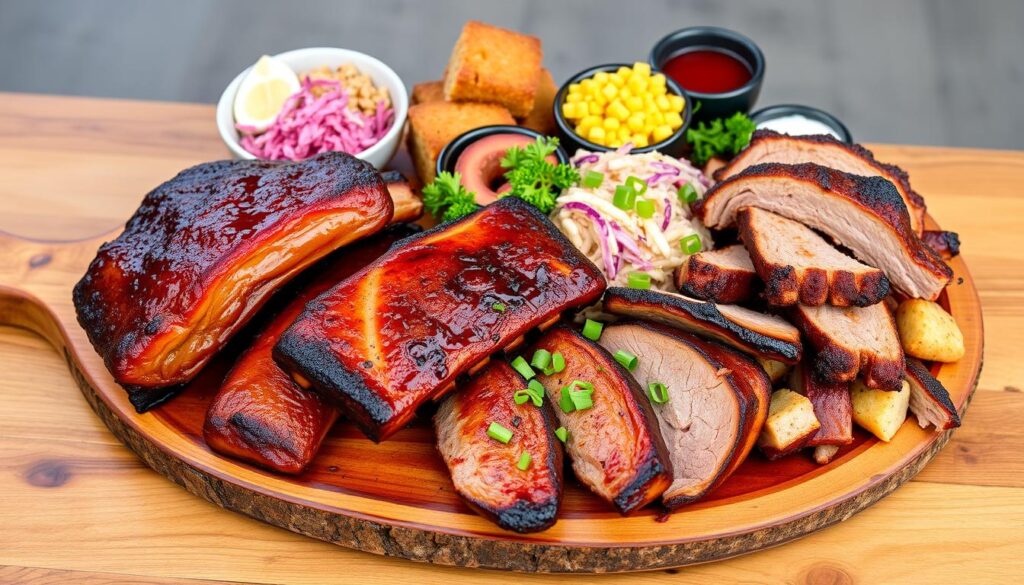
By sticking to the plating and presentation rules, you’ll impress the judges and boost your chances of winning in the BBQ competition.
Choosing the Right Plates and Serveware
Chef Michael Welch says the color, size, and style of your plates matter a lot for BBQ competition entries. Chefs don’t like blue plates because there’s no blue in food and it looks bad. They suggest using white plates or ones that match the food’s.
The size and shape of the plates are important too. They should hold the right amount of food and be easy to carry to the judges.
Choosing serveware that fits your restaurant’s style can enhance the overall visual impact. For instance, a rustic BBQ place might use wooden platters, while a fancy spot might choose modern plates. The goal is to pick plates that make your BBQ look great.
| Plate Color | Recommendation |
|---|---|
| Blue | Avoid, as there are no naturally blue foods |
| White | Recommended to showcase vibrant food colors |
| Complementary Colors | Choose plates that enhance the appearance of your BBQ dishes |
“The size and shape of the plates should also be considered, as they need to accommodate the portions and allow for easy transport to the judges’ table.”
In summary, the right plates and serveware can really change how your BBQ looks. By thinking about the color, size, and style, you can make a great impression on the judges.
Portion Control and Simplicity
In BBQ competitions, smaller portions make dishes look better and taste great. Aim for no more than six items on each plate to avoid crowding. This way, the best ingredients shine and make the dish look appealing.
According to the experts, smaller portion sizes are often easier to style and present beautifully for BBQ competitions. Chefs suggest this method for tasting menus. It focuses on the most tasty and eye-catching parts of each dish. This technique lets the season’s best ingredients be the stars.
But remember, this tip depends on the competition and your restaurant’s style. Some places like big, filling portions as part of their brand. The goal is to find a balance that fits the competition and your restaurant’s identity.
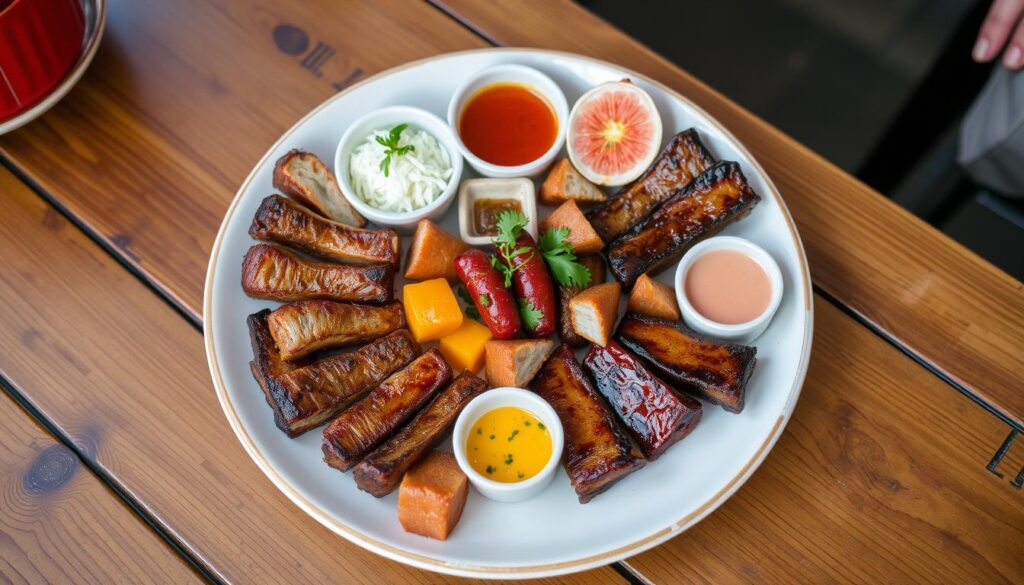
Edible Garnishes and Decorations
Experts say adding edible garnishes and decorations makes your BBQ look and taste better. But, make sure they’re safe to eat, even if they’re not meant to be. Think about using small herbs, leaves, flowers, and thin slices of seasonal foods.
These garnishes should match the dish’s flavors and make it look great. By choosing and arranging them well, you can make your BBQ stand out and impress the judges.
Choosing the Right Edible Garnishes
Here are tips for picking garnishes for your BBQ:
- Small, delicate herbs like rosemary, thyme, or micro greens can add a fresh, aromatic touch.
- Edible flowers, such as nasturtiums or marigolds, can bring a pop of color and a unique flavor profile.
- Thinly sliced seasonal fruits or vegetables, like radishes, citrus, or pickled onions, can provide a crunchy texture and vibrant hues.
The garnishes should not take over the dish but should enhance its flavors.
Presentation Techniques
Here are ways to show off your garnishes:
- Arrange the garnishes in a visually appealing pattern, such as a fan or spiral, to add depth and dimension to the plate.
- Use small, delicate touches, like a sprinkling of micro herbs or a few edible flower petals, to add subtle elegance.
- Incorporate the garnishes into the overall composition of the dish, ensuring they blend seamlessly with the main components.
By following these tips, your BBQ will not only taste great but also look amazing.
“The first bite is with the eye, and presentation is key to creating a memorable dining experience.”
Conclusion
Improving your BBQ competition game is key to winning over the judges and standing out. It’s all about the presentation and how you make your dishes look and taste. Follow the rules, make your food visually appealing, and use different textures and colors.
Make sure your style fits your restaurant’s theme and keep your portions simple yet satisfying. This way, you can make dishes that look great and taste even better. These tips will help you win at your next BBQ competition.
The secret to doing well in BBQ competitions is to impress the judges with your skills. Pay attention to how you plate and present your food. This can take your dishes to a whole new level.
Enjoy the process of getting better at presentation and be proud of turning simple ingredients into amazing dishes. With hard work, creativity, and a commitment to being the best, you can win the competition you’re in.
FAQ
What are some expert tips and strategies for elevating your BBQ competition game through thoughtful plating and presentation?
This article offers tips to boost your BBQ competition skills with great plating and presentation. Key tips include knowing the competition rules, making your dish stand out with height and arrangement, and adding texture and contrast. Also, match your presentation with your restaurant’s theme, keep portions simple, and use garnishes to finish it off.
Why is plating and presentation so important in BBQ competitions?
Food presentation greatly affects how tasty and valuable a dish seems. Good plating makes a dish look more appealing and changes how judges see its quality. Making your competition dishes look better can make them seem more valuable and appealing to judges.
What are the key rules and guidelines to consider when plating your BBQ competition entries?
Before you plate your BBQ, get to know the competition’s rules. These rules cover how to present your dish, what garnishes you can use, and how to serve it. Not following the rules can lead to lower scores, so it’s key to read the guidelines well.
How can you create visual impact and depth on your competition plates?
To make your plates stand out, use height and arrange your food thoughtfully. Techniques like building up from the bottom and using ring molds add depth. Using different colors and textures also makes your plates more appealing.
How should your plating and presentation style align with your restaurant’s theme?
Your plating should match your restaurant’s vibe and theme. For fine-dining places, go for a fancy look. For casual spots, aim for a more rustic style. Keeping your presentation consistent with your restaurant’s theme strengthens your brand and gives judges a cohesive experience.
What are some key considerations when choosing the right plates and serveware for a BBQ competition?
The color, size, and style of your plates matter a lot for presentation. Avoid blue plates and choose white or matching colors for your food. Think about the size and shape of your plates for easy transport and to fit your food well. Serveware that matches your theme and highlights your dishes can make a big difference.
How can portion control and simplicity help with plating and presentation?
Smaller portions are easier to style and look good. Try to keep each plate to six elements to avoid a messy look. This lets you focus on the best ingredients in a way that looks great, fitting your competition and restaurant style.
What role do edible garnishes and decorations play in BBQ competition plating?
Edible garnishes and decorations add flavor and visual interest to your BBQ dishes. Make sure they’re safe to eat, even if they’re just for show. Use small herbs, leaves, flowers, and thin slices of seasonal ingredients that match your dish’s flavors and look.
How to Smoke Ribs to Impress BBQ Competition Judges
Are you ready to boost your backyard barbecue skills and wow BBQ competition judges? Smoking ribs is an art, and we’ll share the secrets to making racks that win praise. Learn how to pick the best cuts and master the smoking process. Get ready to improve your smoke ribs for BBQ competitions, competition-level BBQ, and award-winning BBQ recipes.
Getting ribs ready for a BBQ competition is tough, but with the right smoking techniques, rib rubs, and competition BBQ strategies, you can make delicious, tender ribs. Are you ready to aim for BBQ champion status?
Key Takeaways
- Discover the secrets to smoking competition-worthy ribs that will impress even the toughest judges.
- Learn the essential techniques for selecting the best cuts of ribs and prepping them for the smoker.
- Master the art of seasoning, injecting, and wrapping ribs to achieve the perfect balance of flavor and texture.
- Understand the importance of temperature control and smoke management for competition-level ribs.
- Explore the final touches, including saucing and glazing, that will make your ribs stand out from the crowd.
Introduction to Competition-Style Smoked Ribs
Competition BBQ is all about high stakes and tough judging. If you want to win at a BBQ competition, you must improve your rib-smoking skills. You need to pick the best meat, season it perfectly, smoke it just right, and sauce it to perfection.
The Importance of Impressing Judges at BBQ Competitions
At BBQ competitions, judges look for ribs that are beautiful, tasty, and tender. They have sharp taste buds and an eye for detail. To win, your ribs must be cooked perfectly. They should have a great smoke ring, delicious flavor, and feel like they melt in your mouth.
Overview of the Competition-Style Rib Smoking Process
Smoking ribs for competitions takes careful steps. You start by picking the right meat and seasoning it with a special rub. Then, you manage your smoker’s temperature and smoke levels. Every step is important to make your ribs stand out.
| Key Steps in Competition-Style Rib Smoking | Description |
|---|---|
| Rib Selection | Choosing the best ribs for competitions, considering factors like cut, brand, and marbling. |
| Trimming and Prepping | Properly trimming and preparing the ribs for the smoking process. |
| Seasoning and Injecting | Applying the perfect seasoning blend and techniques for injecting the ribs. |
| Smoker Setup | Selecting the right smoker and fuel source, and controlling temperature and smoke levels. |
| Smoking Technique | Mastering the art of achieving the perfect smoke ring and monitoring the ribs throughout the smoking process. |
| Wrapping and Resting | Properly wrapping and resting the ribs to achieve the desired tenderness. |
| Saucing and Glazing | Creating competition-worthy sauces and glazes, and applying them for maximum flavor. |
Learning about the key parts of smoking ribs for competitions will help you make ribs that wow even the toughest BBQ judges.
Selecting the Best Ribs for Competitions
Winning at BBQ competitions depends a lot on the quality of your ribs. Picking the right pork ribs is key to your success. Look for marbling, thickness, and bone straightness when choosing the best ribs for your smoked masterpiece.
Factors to Consider When Choosing Ribs
Choosing top-notch ribs for competitions requires attention to detail. Here’s what to look for:
- Marbling: Even fat distribution makes ribs juicy and tender.
- Thickness: Ribs should be 1 to 1.5 inches thick for even cooking and structure.
- Bone Straightness: Straight bones mean quality ribs that hold their shape well.
Preferred Rib Cuts and Brands for Competitions
Some rib cuts and brands are known to perform well in competitions. Here are a few:
- Pork Baby Back Ribs from Prairie Fresh, Hormel, and Compart are favorites among BBQ pros.
- St. Louis-Style Pork Ribs from Sam’s Club are also top choices for their quality.
Choosing rib selection for BBQ competitions, competition rib cuts, and competition rib brands helps you make ribs that wow judges and win prizes.
Trimming and Prepping the Ribs
Getting your ribs ready for BBQ competitions means you need to trim and prepare them well. This makes sure they look great and taste amazing. It’s all about making them look perfect for the judges.
Start by taking off the thin, papery membrane on the ribs’ bone side. This membrane stops smoke and seasonings from getting into the meat. So, it’s important to remove it well. Then, cut away any extra fat or silver skin, but don’t take too much off.
After trimming, make sure the ribs are all the same thickness. Look for any thick or uneven parts and trim them down. This makes sure they cook evenly and look professional.
- Remove the membrane from the bone side of the ribs.
- Trim away any excess fat or silver skin.
- Ensure a consistent thickness across the entire rack of ribs.
By doing these rib preparation steps, you’re on your way to making ribs that will wow the judges. Remember, paying attention to every detail is key for competition rib prep and BBQ competition rib trimming.
“Perfectly trimmed and prepped ribs are the foundation for a winning competition entry.”
Smoke ribs for BBQ competitions
To win at BBQ competitions, you need to perfect your seasoning and rubs. The right mix of spices and herbs can turn simple ribs into a hit. Heath Riles BBQ is known for its top-notch competition rubs and innovative flavors.
Importance of Proper Seasoning and Rubs
Seasoning is the secret to great ribs. The right seasoning can boost the meat’s natural flavors. Ingredients like paprika add earthy warmth, while chili powder brings bold, spicy notes. Each spice is key to that perfect taste and look.
Techniques for Injecting and Binding the Ribs
Injecting and binding the ribs are also crucial for juicy, tasty results. Injecting with liquids like broth or apple juice adds moisture and flavor. Binding with twine or special racks keeps the ribs in shape while smoking.
Mastering seasoning, injecting, and binding can take your ribs to the next level. With the right skills and quality ingredients, your smoked ribs will impress everyone. They’ll be unforgettable with every bite.
“The key to competition-worthy ribs is in the details. From the perfect seasoning blend to the techniques that lock in moisture and flavor, every step matters.”
Setting Up the Smoker
To make competition-worthy smoked ribs, you need a detailed plan. The smoker setup is key. You must pick the right equipment and fuel sources for competition smoking.
Choosing the Right Smoker
The Gateway Drum Smoker is a top choice for BBQ competitions. It lets you control the temperature and smoke control well. This means your ribs will taste great and be consistent. It’s also big enough for lots of ribs, perfect for competition.
Selecting the Fuel Source
- For top-notch smoker setup for competition BBQ, use Royal Oak Lump Charcoal. It burns hot and clean, giving you the steady heat needed for smoking.
- Add Tumbleweeds wood chunks or chips for flavor. Hickory, oak, and apple wood are great for smoking ribs.
Getting the temperature and smoke levels right is key. It makes your ribs look and taste great for judges. By controlling the fuel and airflow, you can make sure your ribs are perfect every time.
“The key to winning BBQ competitions is all in the setup. If you don’t have your smoker dialed in, your ribs don’t stand a chance.”
With the right smoker choice for competitions and knowledge of fuel sources for competition smoking and temperature and smoke control, you’re set. You’ll impress the judges and win the trophy.
Smoking the Ribs Competition-Style
To win at BBQ competitions, you need to smoke your ribs with care. The secret to a perfect smoke ring comes from controlling the smoke. This ring is what makes ribs stand out.
Tips for Achieving the Perfect Smoke Ring
The smoke ring is a pink layer under the meat’s surface. It shows the ribs are tasty and high quality. Here are tips to get this ring:
- Use hardwood chunks and chips like oak, hickory, or maple for steady, thin blue smoke.
- Keep the smoker at 225°F to 250°F to smoke evenly.
- Don’t open the smoker door too much to keep the smoke steady.
Monitoring and Adjusting During the Smoking Process
Watching and adjusting your smoker is key to great ribs. Keep an eye on the temperature, smoke, and how the ribs look. This way, you can make small changes to meet the judges’ standards.
| Smoking Stage | Monitoring Considerations | Potential Adjustments |
|---|---|---|
| Initial Smoke | Keep the temperature steady and smoke thin, blue. | Change dampers, add wood chips, or adjust airflow. |
| Wrapping Stage | Make sure the ribs stay wrapped to stay moist and tender. | Adjust how tight the wrap is, add liquid, or change cooking time. |
| Final Saucing | Check the ribs for the right texture and sauce caramelization. | Add or remove sauce, change heat, or apply more glaze. |
Mastering competition rib smoking techniques, achieving smoke ring, and monitoring and adjusting the smoking process will help you make ribs that win. These skills will boost your BBQ skills and impress judges.
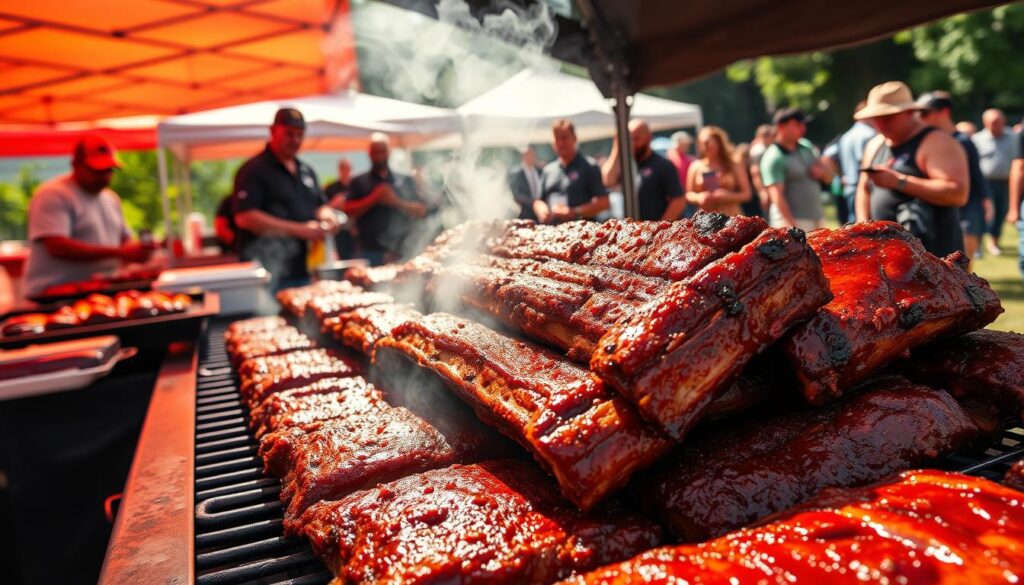
Wrapping and Resting the Ribs
Wrapping and resting the ribs is key in the competition-style smoking process. Doing it right makes the ribs tender, flavorful, and perfect for judges. Let’s look at the best techniques and why this step is so important.
Techniques for Wrapping the Ribs
There are a few top methods for wrapping ribs for competitions. The “foil wrap” method is popular. You wrap the ribs in heavy-duty aluminum foil to keep juices in and make the meat tender.
Another good way is the “butter bath” wrap. You put the ribs in a foil pan with butter or margarine. Then, seal the foil tightly. The butter keeps the meat moist and adds flavor.
Importance of Proper Resting Time
After wrapping, let the ribs rest for the right time. This lets the meat soak up juices and get tender. If you don’t wait, the ribs might be dry and not impress the judges.
The resting time varies by rib size and thickness. It can be 30 minutes to an hour or more. Keep the ribs warm in a cooler or low oven to keep them at the right temperature.
Mastering how to wrap and rest the ribs will help you make amazing smoked ribs. Focus on the details and try different methods to find what works best for you.
Saucing and Glazing the Ribs
Sauces and glazes are key to making competition-style ribs taste great and look appealing. Choosing the right sauces and glazes can make your ribs stand out. This will impress even the toughest BBQ judges.
Creating Competition-Worthy Sauces and Glazes
Making sauces and glazes for BBQ competitions takes skill and knowledge of what judges like. There are many options, from tangy to sweet and smoky. Try different ones, like Heath Riles BBQ sauces and glazes, to find the best match for your ribs.
Applying Sauces and Glazes for Maximum Flavor
Putting sauces and glazes on ribs is an art. You want to balance the flavors so they don’t overwhelm the meat. Try different methods like basting, brushing, or drizzling to get the right look and taste. Mastering this can make your ribs unforgettable to judges.
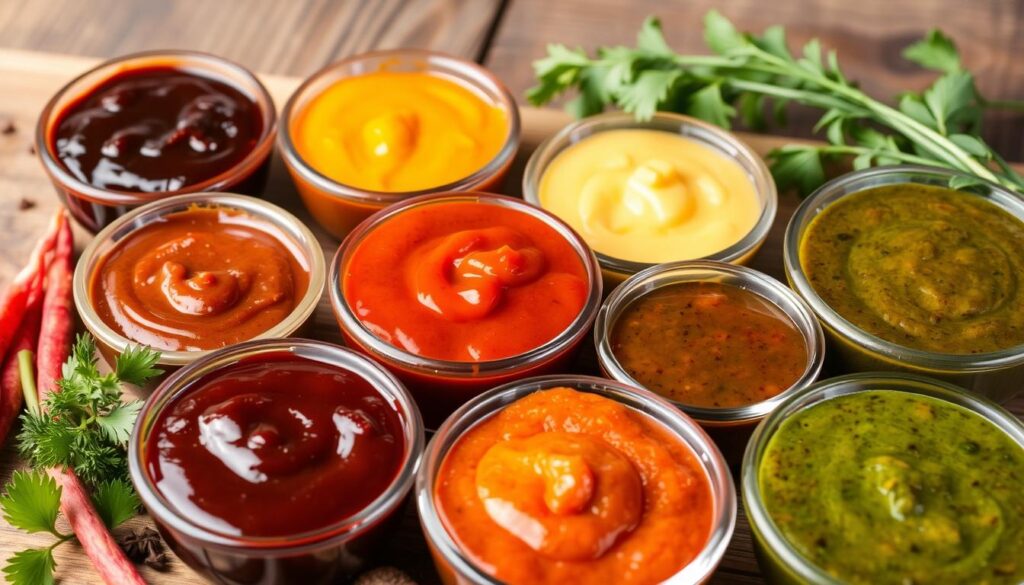
The right mix of sauces and glazes can make your ribs go from good to great. Spend time perfecting how you apply them. This will help you make ribs that wow even the most experienced BBQ fans.
Judging Criteria for Competition Ribs
Want to win at a BBQ competition? It’s key to know what judges look for in ribs. They check the look, taste, and how tender they are. Each factor is crucial for winning.
Understanding Appearance, Taste, and Tenderness Scoring
Judges look at how your ribs look. They want them to be nicely colored, have a clear bark, and look neat. The taste matters a lot too. They check if the flavors are balanced, if the smoke is well mixed, and if they taste good.
How tender the meat is also important. Judges want ribs that are just right – not too hard or too soft. They should be chewy but not tough.
Strategies for Achieving High Scores in Each Category
To get high scores, make sure your ribs look great. Trim and prepare them well. Create a special seasoning mix that makes them look good and taste great.
Also, focus on cooking them just right. Make sure they’re tender but still have a nice texture. This will impress the judges and help you win.
FAQ
What are the key steps involved in smoking competition-worthy ribs?
To smoke great ribs, start by picking the right kind. Then, trim and prepare the racks well. Use the best seasonings and rubs.
Set up your smoker for the right temperature and smoke. Smoke the ribs carefully. Wrap and rest them before adding sauces and glazes.
How do I select the best ribs for BBQ competitions?
Choose ribs with good marbling and straight bones. Look for brands like Prairie Fresh, Hormel, Compart, and Sam’s Club. These have done well in competitions.
What are the best techniques for trimming and preparing competition-style ribs?
Trimming and preparing ribs right is key. Remove the membrane, fat, and any tough spots. Make sure the rack is even and the bones line up.
How do I create the perfect seasoning and rubs for competition ribs?
Mix the right seasonings, like Heath Riles BBQ rubs, to boost flavor and look. Injecting the ribs with liquids and binding the rack helps keep them juicy and together.
What type of smoker and fuel should I use for competition-style rib smoking?
Use a Gateway Drum Smoker with Royal Oak Lump Charcoal and Tumbleweeds for fuel. Keep an eye on the temperature and smoke levels for great results.
How do I achieve the perfect smoke ring on competition ribs?
Watch the ribs closely while smoking. Adjust the temperature, smoke, and timing as needed. A good smoke ring shows the ribs are top-notch.
What are the best techniques for wrapping and resting competition-style ribs?
Wrap the ribs in foil and soak them in butter. Let them rest properly to make the meat tender and flavorful.
How do I create competition-worthy sauces and glazes for my ribs?
Make your own sauces and glazes, like Heath Riles BBQ products. Use the right techniques to boost flavor and look.
What criteria do judges use to evaluate competition ribs?
Judges look at the ribs’ look, taste, and tenderness. For top scores, make sure they look great, taste balanced, and are tender but not too soft.
Advanced Techniques for Smoking Brisket in BBQ Competitions
Are you ready to win at BBQ competitions with your brisket skills? Smoking brisket for contests needs precision and skill more than just grilling. Choosing the right cut and perfecting your presentation is key to impressing judges and winning.
This guide will share advanced techniques used by top pitmasters for brisket perfection. It’s great for both new and experienced BBQ competitors. You’ll get tips that will boost your skills and beat the competition.
Key Takeaways
- Understand the critical judging criteria for brisket in BBQ competitions
- Learn how to select and prepare competition-grade brisket
- Master the art of injecting and seasoning for maximum flavor
- Discover the secrets to the perfect smoking process, from temperature control to wood selection
- Nail the slicing, saucing, and presentation of your competition brisket
Understanding Judging Criteria for Brisket
In BBQ competitions, brisket is a top contender. Judges check it for appearance, taste, and tenderness. Knowing these standards can help you improve your brisket and win over judges.
Appearance: Visual Appeal and Presentation
Your brisket’s first look is crucial. Judges want it to look inviting, with clean slices and a striking presentation. Pay attention to trimming and arranging your brisket to impress.
Taste: Balanced Flavor and Seasoning
For brisket, KCBS judging criteria focus on flavor balance. Judges look for a mix of beef taste, seasonings, and sauces. The aim is a flavor that’s rich but not overpowering.
Tenderness: Achieving the Perfect Mouthfeel
Brisket tenderness and mouthfeel are key. Judges want it to be tender, juicy, and easy to chew. Get this right by smoking it carefully and resting it properly.
Mastering brisket appearance and presentation, brisket flavor and seasoning, and brisket tenderness and mouthfeel can make your brisket a winner.
Selecting and Preparing Competition-Grade Brisket
For BBQ competitions, picking the right brisket is key. You want it to taste great, be tender, and look good. Experts suggest choosing high-quality brisket from top sources like Snake River Farms or Australian A9 Wagyu. This ensures the best marbling and flavor.
Choosing the Right Brisket Cut and Grade
The brisket has two main muscles: the flat and the point. For top-level brisket, pick a cut that combines these well. Look for lots of marbling to make it juicy and tasty.
Proper Trimming Techniques for Competition Brisket
After getting the right brisket, prepare it for the competition. Start by separating the flat and point muscles. Then, trim the edges and fat cap for a neat look. Good trimming makes your brisket stand out.
| Brisket Cut | Ideal Grade | Trimming Considerations |
|---|---|---|
| Flat | Choice or Prime | Trim the edges and fat cap to create a uniform thickness |
| Point | Choice or Prime | Separate the point from the flat, then trim excess fat and uneven edges |
By choosing and preparing your brisket carefully, you’re set to wow the judges. This could be your ticket to the top prize.
Injecting and Seasoning for Maximum Flavor
To make your brisket stand out in BBQ competitions, focus on bold flavors. Use injection and seasoning techniques to bring out the best in your brisket. These steps will make your brisket irresistible to judges, helping you win.
Injecting your brisket with a flavorful marinade changes the game. It adds moisture and seasonings deep into the meat. Try different flavors like brisket injection and seasoning for competitions. Mix spices, herbs, and fruit juices to create a unique taste.
After injecting, enhance your brisket with a competition brisket rubs and marinades. A good dry rub creates a tasty bark on the outside. Choose seasonings that match the injection for the best flavor.
- Try spices like garlic, onion, paprika, and cumin for a unique taste.
- Add brown sugar or honey for sweetness that balances the savory.
- Be bold with ingredients like coffee or cocoa powder for something different.
Success in BBQ competitions comes from balancing injection and seasoning. With attention to detail and new flavors, you’ll make a brisket that judges will love.
“The secret to a truly remarkable competition brisket lies in the art of injection and seasoning. It’s a delicate balance that separates the good from the great.”
Mastering the Smoking Process
To win at BBQ competitions, you need to control the smoking temperature and pick the right wood. Keep your smoker at 225-250°F for even cooking and a great bark. Watch the brisket’s internal temperature and use the right wrapping methods to get through the stall phase. This will make your brisket tender and juicy.
Temperature Control and Wood Selection
Keeping your smoker at 225-250°F is crucial for smoking brisket. This temperature helps cook the brisket evenly and creates a rich bark. Choose woods like oak, hickory, or mesquite for the best smoke flavor.
Monitoring the Stall and Wrapping Techniques
The stall is a tricky part of smoking brisket, where the temperature stops rising. But, you can get past it with the right wrapping methods. Try the Texas Crutch by wrapping the brisket in butcher paper or foil. This keeps it moist and tender, making it perfect for competitions.
| Smoking Brisket Temperatures | Wood Types for Smoking Brisket |
|---|---|
| 225-250°F | Oak, Hickory, Mesquite |
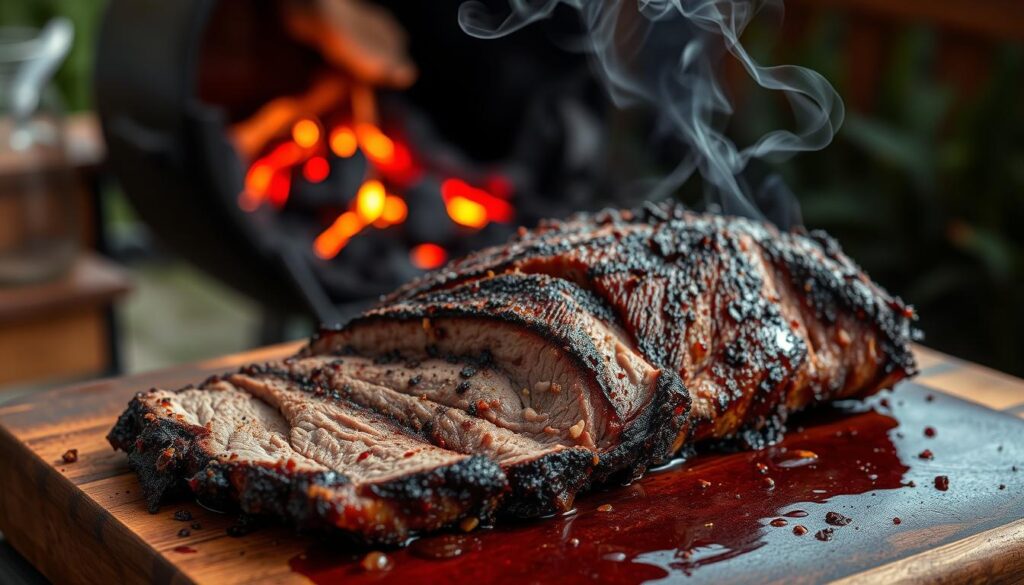
“Proper temperature control and the right wood selection are the foundations of competition-worthy smoked brisket. Mastering these techniques is key to consistently impressing the judges.”
Slicing, Saucing, and Presenting Brisket
Slicing, saucing, and presentation are key steps in making your competition brisket stand out. Getting the slice thickness and appearance right makes your brisket tender and juicy. Using the right sauces can also boost the flavor without taking over the beef taste.
Achieving the Perfect Slice Thickness and Appearance
The best slice thickness for competition brisket is about 1/4 inch. This makes the meat tender and juicy. Slice it against the grain with a sharp knife or electric slicer for even thickness. How you arrange the slices in the box matters too. Make sure they’re evenly spaced and look neat.
Enhancing Flavor with Complementary Sauces
- Pick sauces that bring out the best in your brisket without taking over.
- Think about regional styles like tangy tomato or spicy sauces. Find the perfect mix.
- Use sauces lightly so judges can really taste your smoked brisket.
By focusing on slicing competition brisket and making it look great, you can impress the judges. Adding complementary sauces can also make your dish unforgettable.
Smoking brisket for BBQ competitions
Mastering brisket smoking is key to winning BBQ competitions. It involves selecting the right cut and controlling the smoke. If you’re new or experienced, improving your brisket smoking techniques is vital.
Choosing the right brisket cut is the first step. Opt for USDA Choice or Prime for tenderness and flavor. Remove excess fat and silver skin for a clean look.
- Inject the brisket with a savory marinade to infuse it with maximum flavor.
- Apply a robust dry rub, ensuring an even coating that will produce a delectable bark.
- Carefully monitor the smoking process, adjusting temperatures and wood selection to achieve the perfect balance of smoke and tenderness.
- Wrap the brisket during the stall phase to maintain moisture and accelerate the cooking process.
Slicing and saucing your brisket are key steps too. Make sure the slices are the right thickness to show off the meat’s tenderness. Use a sauce that enhances the smoky flavor.
| Technique | Description |
|---|---|
| Brisket Selection | Choose a USDA Choice or Prime grade brisket for optimal tenderness and flavor. |
| Trimming | Carefully remove excess fat and silver skin to create a clean, uniform appearance. |
| Injection | Use a savory marinade to infuse the brisket with maximum flavor. |
| Seasoning | Apply a robust dry rub for a delectable bark. |
| Smoking Process | Precisely control temperatures and wood selection to achieve the perfect balance of smoke and tenderness. |
| Wrapping | Wrap the brisket during the stall phase to maintain moisture and accelerate the cooking process. |
| Slicing | Achieve the perfect slice thickness to showcase the tender, juicy interior. |
| Saucing | Complement the smoky notes with a carefully crafted sauce. |
“Smoking brisket for BBQ competitions is a true art form, requiring a deep understanding of the process and a relentless pursuit of perfection.”
Whether you’re a pro or new to BBQ, mastering smoking brisket for BBQ competitions is crucial. With the right skills and dedication, you can improve your brisket and win top spots in big competitions.
Boxing and Turning In Brisket
The final step in the competition is how you present your brisket. Arranging the slices or burnt ends in the box well can really help your entry. It’s important to follow the rules about how many slices and their size or where they go.
Presentation Tips for Competition Boxes
Creating a box that catches the eye is key. Here are some tips for a great brisket competition box presentation:
- Arrange the brisket slices in a way that looks good, focusing on symmetry and pattern.
- Make sure all slices are the same thickness to show your skill in cutting.
- Adding garnishes or sauces can make your brisket for competitions look even better.
- Keep the box clean, with no spills or drips.
- Follow the competition’s rules carefully, as small details matter.
Judges look at more than just the taste and softness of your brisket. They also notice how it looks. Spending time to make your brisket for competitions look great can really help you win.
“The devil is in the details when it comes to presenting your brisket for competition. Paying close attention to the arrangement and appearance of your box can be the difference-maker.”
| Criteria | Importance |
|---|---|
| Slice Arrangement | High |
| Slice Thickness | Medium |
| Garnishes/Sauces | Medium |
| Cleanliness | High |
| Following Guidelines | High |
Timelines and Checklists for Competition Day
Successful BBQ competitions need careful planning and organization. Start planning long before the event day. Make detailed BBQ competition timelines for each meat type. This includes getting and prepping ingredients and cooking them.
Having a complete competition BBQ checklists for equipment, supplies, and more is key for a smooth day. This lets the pitmaster focus on making top-notch brisket and other meats. Plan and adjust your timelines with past experiences and judge feedback to succeed on competition day.
- Make a detailed timeline for each meat type. Include sourcing, prepping, and cooking steps.
- Put together a full checklist of all needed equipment, supplies, and essentials for the day.
- Look over and improve your timelines and checklists based on past competition feedback.
- Make sure everything on your checklist is ready to go before the competition begins.
“Preparation is the key to success in any BBQ competition. By having a solid plan in place, you can focus on delivering your best work on the day of the event.”
With a solid timeline and a detailed checklist, you’re ready to face the big stage. This will help you increase your chances of winning in your next BBQ competition.

Strategies for Consistent Top Placements
To win at BBQ competitions, you need a plan that keeps getting better. This means always improving your skills and learning from what you’ve done before. Paying attention to what judges say can show you where you can get better. This includes how your brisket looks, tastes, and feels.
Analyzing Feedback and Refining Techniques
Using the feedback you get can help you get better at BBQ. Try new things in practice to see what works best. Look at what judges say to see what you can do better. This could be about how you season, smoke, or slice your brisket.
- Carefully review any written feedback from judges to identify areas for improvement.
- Observe and take notes on the judges’ reactions and comments during the competition.
- Experiment with different rubs, injections, and smoking techniques during practice to refine your process.
- Solicit feedback from experienced pitmasters and mentors to gain valuable insights.
Getting better at BBQ competitions means using what you learn to improve. Keep trying new things and stay open to advice. This way, you can get better at smoking brisket and win more often.
| Feedback Type | Key Insights | Action Items |
|---|---|---|
| Appearance | Needs more uniform slicing, better bark development | Experiment with different slicing techniques, adjust seasoning and smoking time |
| Taste | Flavors could be more balanced, seasoning needs refinement | Try new rub recipes, adjust injection method, experiment with wood types |
| Tenderness | Slightly overcooked, could use more moisture retention | Refine temperature control, consider wrapping techniques, adjust cooking time |
By working on the feedback you get and always improving, you can do great in BBQ competitions. This way, you’ll be on your way to success in analyzing feedback to improve brisket.
Conclusion
Learning to smoke brisket for BBQ contests is a journey of ongoing learning and improvement. By knowing the judging criteria, picking the right brisket, and using advanced smoking methods, pitmasters can get better. They can make their brisket stand out and often win.
Success in brisket contests comes from pleasing the judges with looks, taste, and softness. Choosing the best cut and mastering smoking and slicing are key. Every step is important for a brisket that makes a big impact. By staying updated, practicing a lot, and using feedback, you can get better at BBQ.
Keep aiming for barbecue greatness, and remember the journey is the best part. Every contest is a chance to learn, improve, and explore new things in your BBQ skills. Stay motivated, keep your focus, and always aim to improve your brisket smoking for BBQ contests.
FAQ
What are the key elements of smoking brisket for BBQ competitions?
To win at BBQ competitions, you need to master smoking brisket. This means picking top-quality meat, using the right injection and seasoning, and perfecting the smoking process. Don’t forget about slicing and saucing your brisket just right.
How are briskets evaluated in BBQ competitions?
Briskets are judged on how they look, taste, and feel. Judges check the meat’s appearance and how well the beef and seasonings mix. They also look for a juicy, tender texture.
What type of brisket is best for BBQ competitions?
For the best results, choose high-quality brisket. Look for options from Snake River Farms or Australian A9 Wagyu. These have great marbling and flavor.
How do injection and seasoning techniques impact competition brisket?
Injecting the meat with flavor and applying a dry rub are key. The injection adds moisture and seasoning. The dry rub creates a tasty bark on the outside.
What are the critical factors for achieving competition-worthy smoked brisket?
Keeping the smoker at 225-250°F is important for even cooking. Using the right wood helps create a great bark. Watch for the stall and wrap the meat correctly for tender results.
How should brisket be sliced, sauced, and presented for BBQ competitions?
Slice the brisket to about 1/4 inch for the best texture. Sauces can add flavor but shouldn’t hide the beef taste. Make sure your brisket looks great in the box to impress the judges.
What are the essential steps for turning in competition-ready brisket?
Arrange your brisket slices neatly in the box to show off their look and feel. Follow the rules on portion sizes and slice thickness to stand out.
How can pitmasters ensure a smooth competition day for brisket?
Plan your day with timelines and checklists for all your gear and supplies. This helps you focus on making amazing brisket and other meats.
What strategies can help pitmasters achieve consistent top placements in BBQ competitions?
Listen to what judges say, whether it’s on comment cards or from their feedback. Use this advice to improve your brisket’s look, taste, and tenderness. Try new things in practice to stay ahead.
Choosing the Right Cuts of Meat for BBQ Competitions
Are you ready to boost your backyard barbecue skills and enter the competitive smoking and grilling world? The key to winning may be in the meat you pick. From brisket to pork shoulder, each type has special traits that can make or break your success. But do you know what makes meats perfect for competitions?
Key Takeaways
- Understand the key factors that judges consider when evaluating competition-level meats, such as marbling, fat content, and muscle fibers.
- Discover the optimal cuts of beef, pork, and other proteins that thrive in the intense heat and scrutiny of BBQ competitions.
- Learn how to select the perfect brisket, pork shoulder, beef ribs, and more to showcase your culinary expertise.
- Explore the regional variations and personal preferences that shape the world of competitive barbecue.
- Uncover the specialized cooking techniques that can help you master the art of competition-ready meats.
Introduction to Competitive Barbecuing
Competitive barbecuing takes the simple act of grilling to a new level. It’s not just about enjoying food with friends. In BBQ competitions, the focus is on skill and precision. This can make the difference between winning and losing.
Understanding the Judging Criteria
The Kansas City Barbecue Society (KCBS) sets the rules for judging in competitive barbecuing. A panel of six judges scores each meat from 2 to 9, aiming for a perfect 180 points. They look at the meat’s look, taste, and how tender it is. They want that perfect mix of flavors and textures.
Differences between Competition and Backyard Barbecue
One big difference is what judges like. They prefer a neat, tender bite, not the super tender ribs for casual barbecues. To win, competitors use special cooking methods, seasonings, and ways to present their food.
| Competitive Barbecuing | Backyard Barbecue |
|---|---|
| Precise cooking techniques and seasonings | Casual, relaxed approach |
| Focused on appearance, taste, and tenderness | Emphasis on enjoying good food and company |
| Striving for a clean, tender bite | Favoring “fall-off-the-bone” ribs |
Competitive barbecuing is exciting and challenging. It’s where love for great food meets the desire to be the best. Knowing how judges score and the differences with backyard barbecues can improve your grilling skills. You could become a true pit master.
Selecting the Best Beef Brisket
Choosing the right beef brisket is key. Look for a packer-trimmed whole brisket with both the point and flat muscles. USDA Prime is top-notch, but Choice is also great for BBQ competitions. Check for fat marbling and flexibility to ensure tenderness and moisture.
Grading and Marbling
The USDA grading system helps judge beef brisket quality. Prime has lots of marbling, making it the best choice. Choice is also good, with enough fat for tenderness and flavor. But, Select grade might not have enough marbling for top competition.
Fat Content and Flexibility
Don’t forget about fat content and flexibility when picking brisket. A bendable brisket means it will be tender. But, a stiff brisket might be too tough for competition.
“A high-quality beef brisket with the right balance of fat content and flexibility can make all the difference in a BBQ competition.”
Choosing the Perfect Pork Shoulder
In competitive barbecuing, the pork shoulder, or pork butt, is key. You need to pick the right cut for tenderness, juiciness, and flavor. Stay away from pork that’s been injected with solutions. This can ruin the natural marbling and fat that make BBQ great.
Choose a pork shoulder that’s reddish-pink and has a pearl-white fat cap. It should have fat marbling in an irregular pattern, or “fat veining.” This shows the pig was well-fed and happy. This fat makes your pork shoulder juicy and tender while smoking.
Avoiding Enhanced or Injected Meat
Enhanced or injected pork might look better, but it’s not worth it. These treatments can lower the meat’s quality and taste. Always go for pork shoulder without added solutions or enhancements. This lets the meat’s natural flavors come through.
Marbling and Fat Distribution
Marbling and fat distribution are crucial for a winning pork shoulder. Look for even fat throughout for a juicy, tasty result. Stay away from pork with too much fat or uneven marbling. These can make your meat dry or cook unevenly.
“The perfect pork shoulder is the foundation of a truly exceptional barbecue dish. By selecting the right natural pork with the ideal marbling and fat distribution, you’re well on your way to impressing the judges and taking home the trophy.”
Best Cuts of Meat for BBQ Competitions
Beef brisket and pork shoulder are top choices in BBQ competitions. But, the best meat for BBQ can change based on where you are. Chicken, turkey, lamb, and goat are favorites in some places. Knowing how to cook each meat is key to winning.
For beef, top picks include:
- Beef clods: These big, tough cuts need careful trimming and slow cooking to be tender.
- Tri-tips: These come from the sirloin and are tasty and tender when cooked right.
- Beef ribs: These can be hard to make, but they offer a rich beef flavor judges love.
Pork shoulder is a classic choice, but some cooks prefer pork ribs or whole hog for something different.
Chicken and turkey are big hits for poultry, with perfect skin and juicy meat being the goal.
Lamb and goat offer unique flavors that can impress the judges.
Success in BBQ competitions comes from perfecting how you prepare and cook each meat. With the right skills, you can make a dish that wows the judges.
Preparing Beef Clods and Tri-Tips
Beef clods and tri-tips are great for BBQ contests because of their special muscle fibers. They are softer than brisket, making them a favorite among BBQ pros.
Understanding Beef Muscle Fibers
Beef clods come from the chuck or shoulder and have different tenderness levels. You can make them tender with slow cooking. The mix of muscle fibers in the clod creates a mix of textures and tastes, perfect for BBQ contests.
Tri-tips, on the other hand, are from the sirloin and have fibers that go in one direction. This makes them easy to cut into thin slices, which are super tender. Because of their simple muscle structure, tri-tips are a top pick for BBQ pros who like things to be consistent.
- Beef clods offer a range of tenderness levels that can be managed through low, slow cooking
- Tri-tips have a single, uniform muscle fiber direction, making them easy to slice across the grain for maximum tenderness
- Both beef clods and tri-tips can be excellent choices for BBQ competitions due to their unique muscle fiber compositions
“Understanding the muscle fiber structure of different beef cuts is key to achieving the perfect texture and tenderness in competition barbecue.”
Mastering Beef Ribs
In BBQ competitions, beef ribs show how good a pitmaster is. Whether you’re using beef back ribs or beef short ribs, you need special skills. These cuts need the right techniques to be tender and full of flavor.
Beef ribs have a lot of connective tissue. This means they need to cook slowly over low heat. This breaks down the tough fibers, making the meat tender. It’s important to watch the cooking time and temperature closely for the best results.
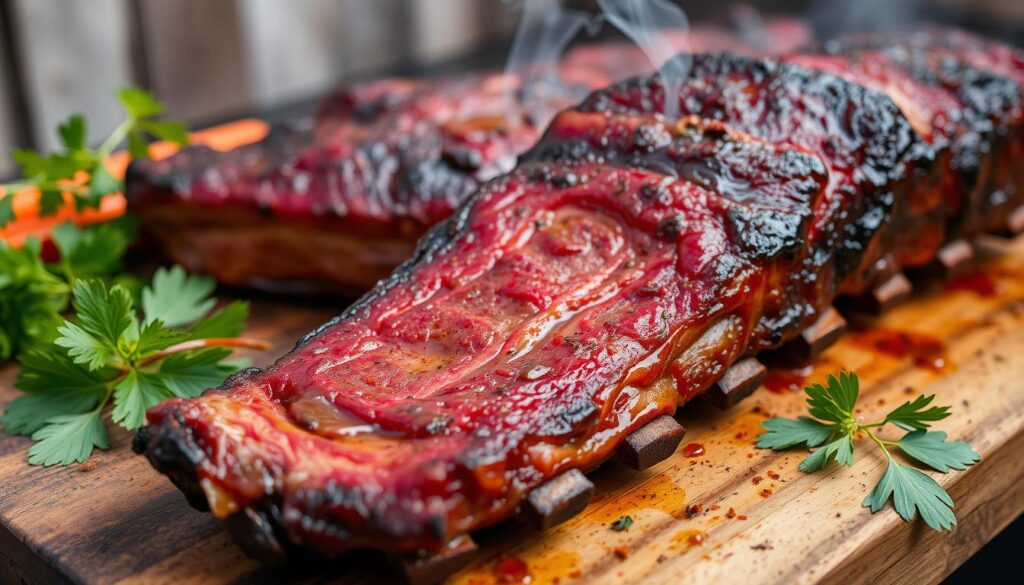
- Pick high-quality beef ribs with lots of marbling and fat. This keeps the meat juicy and tasty during cooking.
- Season the ribs well with a dry rub or marinade. This lets the flavors soak into the meat.
- Cook the ribs low and slow, using smoke and braise techniques. Try to get the meat to an internal temperature of about 200°F. This makes sure the connective tissue is fully broken down.
- Try different wood chips or pellets to give your beef ribs a special smoky taste.
- Let the ribs rest for at least 30 minutes before serving. This lets the juices spread evenly throughout the meat.
With patience, careful attention, and some experimentation, you can make your beef ribs stand out. They’ll be so tender and flavorful, the judges will be impressed.
| Cut | Characteristics | Ideal Cooking Method |
|---|---|---|
| Beef Back Ribs | Larger, meatier ribs with more connective tissue | Low and slow smoking, braising |
| Beef Short Ribs | Smaller, more concentrated flavor with higher fat content | Slow smoking, braising |
“The secret to competition-worthy beef ribs lies in your ability to tame the connective tissue and bring out the natural sweetness and umami flavors in the meat.”
Conquering Pork Ribs
Pork ribs, whether pork spare ribs or pork loin back ribs, need special cooking methods. These methods help break down the tough fibers. This makes the ribs tender and juicy. Competitors use different ways to make these tough cuts perfect for the judges.
Dealing with Connective Tissue
Working with pork ribs is tough because of the connective tissue. This tissue makes the ribs chewy if not cooked right. To beat this, competitors use several tricks:
- Trimming: Removing extra connective tissue makes the ribs softer and tastier.
- Scoring: Cutting the connective tissue shallow helps it cook down better.
- Membrane Removal: Taking off the thin membrane on the ribs ribs helps seasonings go in better and breaks down the connective tissue faster.
With these methods, pitmasters can turn tough pork ribs into delicious, tender pieces. These ribs win over judges at BBQ contests.
“The key to conquering pork ribs is patience and attention to detail. With the right techniques, you can transform even the toughest cuts into melt-in-your-mouth perfection.”
Regional Favorites
Beef and pork are common in competitive barbecue, but some areas have their own special tastes. Chicken, turkey, lamb, and goat are favorites in different places. Knowing these regional tastes can help you win in specific contests.
Chicken and Turkey
In certain areas, chicken and turkey are the main dishes. These meats need to be cooked carefully to avoid drying out. Learning to make smoked chicken or roasted turkey can really impress judges and make your dish stand out.
Lamb and Goat
Lamb and goat are great for those who want to be different. They have strong flavors that can really catch your taste buds’ attention. But, they also need special care to cook well and show off their best taste.
Whether you’re grilling chicken and turkey or trying out lamb and goat, knowing what the judges like can help you win. Tailoring your cooking to the local tastes can make your barbecue unforgettable.
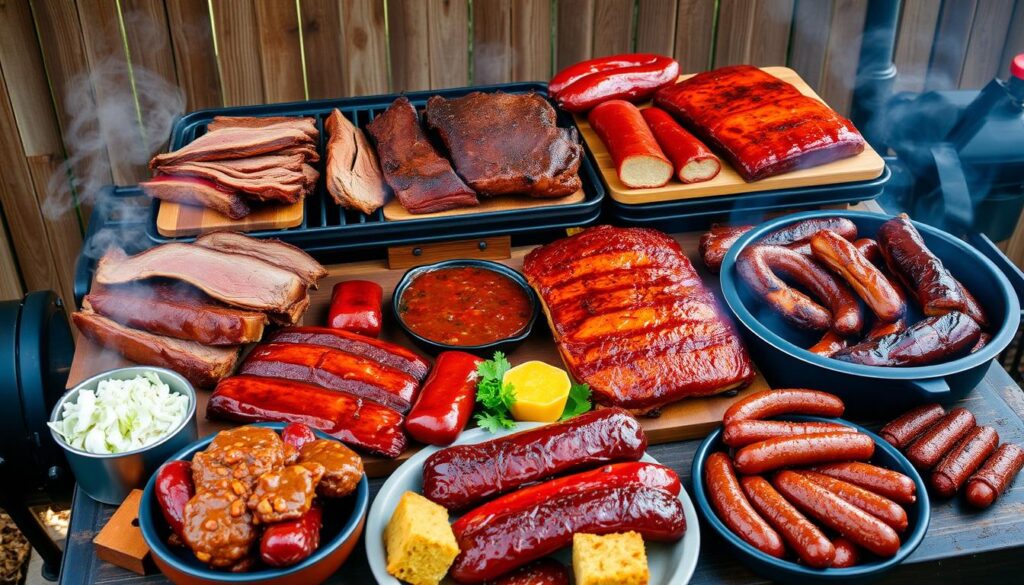
“The true secret to winning a barbecue competition lies in embracing the regional flavors that set your entry apart from the rest.”
Cooking Techniques for Competition Meats
Competitive barbecue needs special cooking skills to impress judges with flavor and texture. Competitors use rubs, sauces, injections, and brining to make each meat bite stand out. These methods are different from backyard grilling, showing the unique challenges of competitive barbecue.
Using well-made rubs is key in competitive barbecue cooking techniques. These dry seasonings add layers of flavor and bring out the meat’s natural taste. Competitors spend a lot of time perfecting their rub recipes, mixing spices, herbs, and other ingredients for a unique flavor.
Sauces are also vital in competition barbecue. They add moisture and boost the meat’s flavors when used to baste it during cooking. Competitors use various sauce methods, like mopping, basting, or injecting it into the meat.
Injections and brining are important too. They fill the meat with a tasty liquid to keep it moist and tender. Competitors try different injection and brining mixes, from simple to complex blends with herbs, spices, and fruit juices.
Knowing these competition barbecue cooking techniques is key to winning. By mixing the right rubs, sauces, injections, and brining, competitors can make barbecue dishes that wow the judges and stand out.
Conclusion
In the world of BBQ competitions, picking the right meat and cooking it right is key. Knowing about beef, pork, and other proteins helps you improve your barbecue. It also helps you understand what judges look for and what people in different areas like.
This guide has given you the knowledge and tools to win at competitions and impress everyone. You now know how to pick the best beef brisket and cook pork ribs like a pro. You’re ready to take your competitive barbecue skills to the next level.
Whether you’re new to BBQ competitions or you’ve been doing it for years, this guide has given you the important tips for meat selection and cooking techniques. With this knowledge, you’re ready to improve your barbecue skills and become a true pit master.
FAQ
What are the best cuts of meat for BBQ competitions?
Top meats for BBQ contests include beef brisket, pork shoulder, beef ribs, pork ribs, tri-tip, and chuck roast. The quality of these meats is key. Look for good marbling and the right fat content to impress judges.
How does competitive barbecuing differ from backyard grilling?
Competitive BBQ is a unique skill. It’s not like grilling at home. Judges look for specific qualities like “fall-off-the-bone” ribs. But, they prefer tender meat that’s easy to bite into.
Competitors use special cooking methods and seasonings to make their dishes stand out.
What should I look for when selecting a beef brisket for competition?
Choose a high-quality beef brisket with both point and flat muscles. Opt for USDA Prime or Choice grade. Check for good fat marbling and flexibility for tenderness.
What are the key considerations for selecting a pork shoulder (or pork butt) for competition?
Pick all-natural pork shoulder without added solutions. Look for a reddish-pink color and a pearl-white fat cap. Good fat marbling means the pig was well-fed.
Are there other cuts of meat that can be successful in BBQ competitions?
Yes, other meats like chicken, turkey, lamb, and goat can win in BBQ contests. Each meat has its own cooking needs. Knowing these can help you succeed.
How do beef clods and tri-tips differ from brisket in competition?
Beef clods and tri-tips are tender meats great for BBQ contests. Clods come from the chuck area and vary in tenderness. Tri-tips are from the sirloin and are easy to slice for tenderness.
What techniques are required to cook beef ribs and pork ribs for competition?
Beef ribs need special cooking to be tender and flavorful. They have a lot of connective tissue. Pork ribs also need slow cooking to be tender and juicy.
How can competitors cater to regional preferences in BBQ competitions?
Some BBQ contests favor chicken, turkey, lamb, or goat over beef and pork. Knowing what’s popular in each region can help you win.
What specialized cooking techniques are used in competition barbecue?
BBQ contests demand special cooking skills. Competitors use complex rubs, sauces, and injections to impress judges. These methods are different from backyard grilling.
How to Marinate and Brine Meats for BBQ Competitions
Grilling and BBQ get a boost from marinating meat. It adds flavors, tenderizes, and makes the meat juicy and tender. We’ll cover the basics and advanced techniques to help you master the grill.
Ever wondered what makes BBQ champions stand out? Their secret is in marinating and brining meats. Ready to learn the secrets of top-level barbecue?
Key Takeaways
- Marinating and brining meats is key for great BBQ flavors and tenderness.
- Knowing the marinade components and brining science helps create unique flavors.
- Right marinating and brining methods ensure food safety and the best flavors.
- Trying different spices and herbs can lead to unique, award-winning BBQ recipes.
- Improving smoking, grilling, and tenderizing skills can elevate your BBQ.
Introduction to Meat Marination
Grilling and barbecuing become amazing when you use the right meat marinades. Meat marinades add a burst of flavors and keep the meat juicy. They’re key to making your meals tender and delicious.
Importance of Marinades
Marinades are vital for great barbecue or grilling. They keep meat from drying out and getting tough. The mix of key components of a marinade, like acids, oils, herbs, and spices, tenderizes the meat. This mix also brings out flavors you wouldn’t get otherwise.
Key Components of a Marinade
The main parts of a marinade are:
- Acid: Things like citrus juices, vinegar, or wine make the meat tender and tasty.
- Oil: Olive oil or avocado oil keep the meat moist and prevent it from sticking to the grill.
- Herbs and spices: These add lots of flavors and tenderizing qualities to the meat.
Knowing how meat marinades work and what’s in them can open up new flavors for your barbecue.
Marinating Techniques
Learning how to marinate can take your barbecue to the next level. Whether you’re entering a competition or just want to make your meats taste better, knowing the right marinating methods is key. Let’s explore the strategies that turn your meat into delicious dishes.
First, it’s important to understand the role of timing in marinating. Different meats need different marinating times. For example, poultry and seafood usually do well with 1-2 hours, while red meats can soak for 4-24 hours. It’s crucial for the meat to soak up the flavors fully to get the right taste and tenderness.
Keeping an eye on the temperature is also vital during marinating. Always marinate your meats in the fridge to avoid harmful bacteria. This keeps your food safe and helps the marinade work better. Before cooking, make sure the meat is at room temperature for even cooking.
- Make sure the meat is fully covered in marinade by using a sealed bag or airtight container.
- Keep the marinating meat in the fridge until you’re ready to cook, keeping it at the right temperature.
- Let the marinated meat warm up to room temperature before cooking for even heat.
| Meat Type | Marinating Time |
|---|---|
| Poultry | 1-2 hours |
| Seafood | 1-2 hours |
| Red Meat | 4-24 hours |
By using these marinating techniques, you’ll make your meats tender, flavorful, and ready for the best barbecue.
Food Safety Considerations
When marinating meats for BBQ competitions, food safety is key. Keeping meats safe from harmful bacteria is crucial. This ensures your guests stay healthy and safe.
Always marinate meats in the fridge, keeping it under 40°F (4°C). Leaving meats at room temperature lets bacteria grow. This risks making people sick. Don’t leave marinated meats out too long.
Also, watch out for cross-contamination. Use different cutting boards and tools for raw and cooked meats. Throw away any marinade that touched raw meat. It could have harmful germs.
- Marinate meats in the refrigerator, maintaining a temperature below 40°F (4°C)
- Use separate cutting boards and utensils for raw and cooked meats
- Discard any leftover marinade that has been in contact with raw meat
By following these guidelines, your marinated meats will be tasty and safe. Putting food safety first keeps your guests safe. It also makes you look good as a BBQ competitor.
“Food safety should never be compromised, even in the pursuit of culinary excellence.”
Marinate and Brine Meats for BBQ Competitions
Preparing meats for BBQ competitions requires careful attention to marinating and brining. These steps boost flavor and tenderness. They also keep your food safe during the competition.
Time and Temperature Guidelines
The right marinating and brining times and temperatures vary by meat type and cut. Thinner meats like chicken or pork tenderloin need 2-4 hours. Tougher meats like brisket or pork shoulder do well with 6-12 hours.
The best marinating temperature is between 40°F and 140°F. The lower end helps prevent bacteria from growing.
Sealing and Refrigerating
Keeping meats safe and tasty means sealing them in airtight bags or containers. Refrigerate them during marinating or brining. This locks in flavors and keeps meat safe from contamination.
Check your fridge’s temperature often. Make sure it stays within the safe range. Don’t leave meats at room temperature for too long.
By following these guidelines and sealing and refrigerating properly, you can improve your meats’ performance in BBQ competitions. Your dishes will impress the judges with their delicious taste.
Lane’s Recipes Using Marinades
Lane’s BBQ is your go-to for BBQ competition meats. They offer a variety of seasonings, sauces, and marinades. These can help you make flavors that will wow the judges. The Pow Pow marinade and the W sauce from Bear and Burton are top picks.
The Pow Pow marinade adds a burst of Asian flavor to your meats. It’s made with soy sauce, garlic, ginger, and a hint of sweetness. This marinade turns your proteins into tender, flavorful dishes. Try it with steak, chicken, or seafood to find the perfect balance of flavors.
The W sauce from Bear and Burton is great for marinating meats. It’s a versatile sauce that adds a rich, smoky flavor. Use it with Lane’s rubs and seasonings for a perfect blend of flavors. This will make your BBQ stand out.
You can also make your own marinades with Lane’s products and other ingredients. Mix different flavors like sweet and spicy, or herbal and citrusy. This way, you can create unique marinades for your competition dishes. The right marinade can turn ordinary meats into amazing dishes that impress the judges.
“The right marinade can make all the difference in the world when it comes to competition BBQ.”
Exploring Flavor Combinations
Mastering meat marination opens up a world of amazing flavor combinations and tender textures. These will wow your guests at any grilling or BBQ event. By trying out different spices and herbs, you can make your own unique marinades. These will match the meats and show off your style and creativity.
Customizing Marinades
Boost your barbecue skills by customizing marinades to fit your taste. Begin by checking out various herbs, spices, and other ingredients. These can add depth and complexity to your marinades. You can use classic seasonings like garlic, onion, and paprika, or go for exotic tastes like cumin, ginger, and za’atar.
- Try out different flavor combinations to find what you like best.
- Change the ingredient ratios to balance sweetness, acidity, and heat.
- Add fresh or dried herbs and spices for more complexity and aroma.
- Feel free to be creative and try new customized marinade recipes.
The secret to great flavor combinations is to stay open-minded and enjoy the process. Embrace the art of experimenting. Let your taste buds lead you on a tasty journey of discovery.
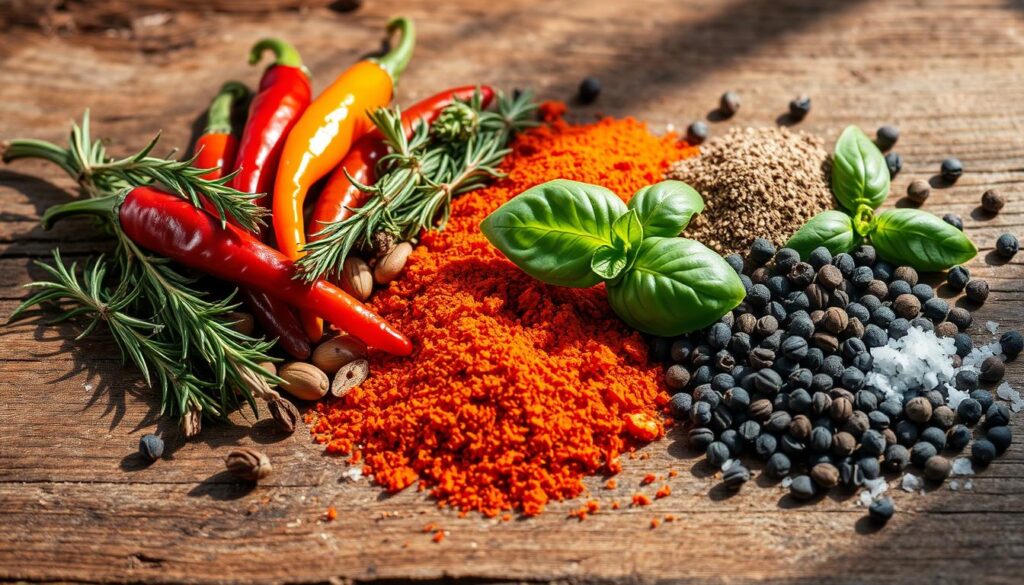
“Creativity is allowing yourself to make mistakes. Art is knowing which ones to keep.” – Scott Adams
Award-Winning Barbecue Mastery
To win at BBQ contests, you need to know how to marinate and cook. Mastering smoking and grilling can make your ribs stand out. It adds a mix of flavors that judges love.
Unlocking Flavor through Smoking and Grilling
Getting the right temperature, timing, and wood is key for great BBQ flavor. Try different smoking woods and cooking times to impress the judges.
- Control the temperature to cook meats perfectly. They should have a smoky smell and be juicy and tender.
- Plan your cooking time based on the meat’s type. This helps get the meat just right.
- Use various hardwood smoking chips like oak, maple, cherry, and mesquite. They add complex flavors.
Mastering smoking and grilling lets you make BBQ that wins contests. Each bite will show off your skill and love for BBQ. Judges will notice the deep flavors and your attention to detail.
“The key to award-winning barbecue is finding the perfect balance between the marinade and the smoking and grilling techniques. It’s a delicate dance, but when you get it right, the results are truly magical.”
As you improve your smoking and grilling techniques, focus on creating unique flavors for the judges. With hard work and creativity, you can make your BBQ stand out. You might even become an award-winning champion.
Tenderizing Meats for Competitions
In the world of barbecue competitions, paying attention to details is key. Tenderizing your meats can be a big step up. It helps make your meats tender and juicy, perfect for the competition stage. Let’s look at how tenderizing can improve your competition dishes.
Tenderizing meats means breaking down tough tissues that make meat chewy. You can use pounding, scoring, or enzymatic marinades to make your meats tender and tasty. By focusing on the texture and tenderness, you can impress judges and stand out.
- Pounding: Use a meat mallet or a heavy pan to gently pound the meat. This breaks down the fibers and makes tougher cuts like brisket or pork shoulder tender.
- Scoring: Scoring the meat’s surface with a sharp knife helps tenderization. It lets marinades and seasonings go deeper.
- Enzymatic Marinades: Ingredients like pineapple, papaya, or kiwi have enzymes that break down meat proteins. This makes the meat more tender.
Finding the right balance in tenderizing is crucial. You need to break down the meat but keep it intact. Try different methods to see what works best for your competition and the meat you’re using.
“Tenderizing your meats is not just about creating a melt-in-your-mouth experience for the judges. It’s a strategic move that can set your competition dishes apart and give you a real edge in the world of barbecue mastery.”
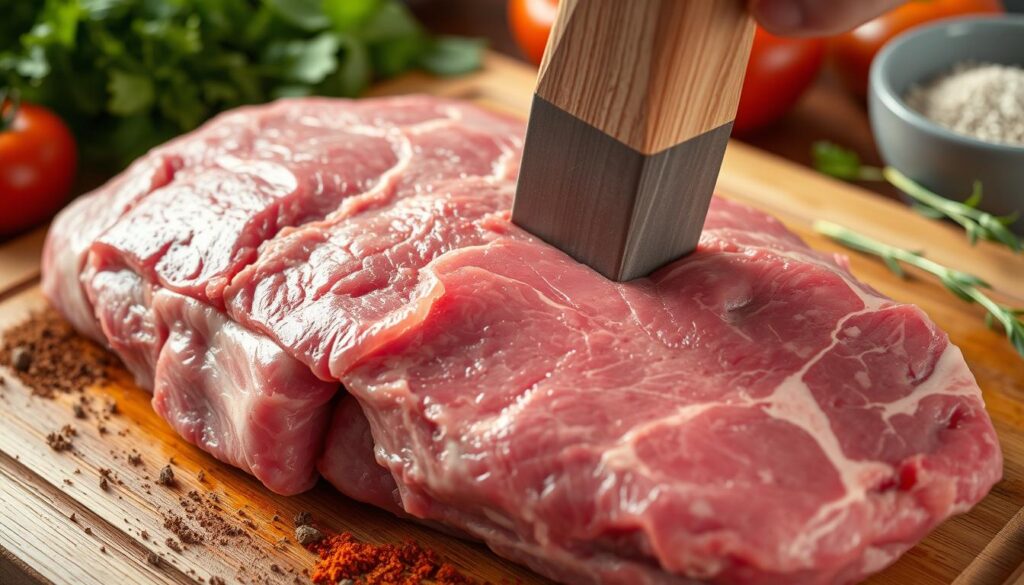
As you work on your competition skills, remember tenderizing is just part of it. Paying attention to meat texture and tenderness, along with great marinades and smoking/grilling, can take your barbecue to the next level. This can help you win those big competitions.
Conclusion
Mastering marinating and brining meats is key to winning in BBQ competitions. These techniques add bold flavors and make tough cuts tender. By trying different marinades and spices, you can create a unique style that stands out.
The path to BBQ mastery involves learning and improving. Focus on making your meats taste better and tender. This will help you win awards in BBQ competitions. Marinate and brine with confidence, showing off your love for barbecue in every bite.
Keep improving your skills and remember to handle food safely. Combine your cooking skills with attention to detail and a focus on quality. This will help you succeed in competitive BBQ. Show off your marinating and brining skills and let your passion for barbecue lead you to success.
FAQ
What are the key components of a marinade?
A marinade has acid like citrus juices and vinegar to tenderize the meat. It also has oil to keep the meat moist and prevent it from sticking. Plus, it includes herbs, spices, and seasonings for bold flavors.
How long should I marinate different types of meat?
Marinating times vary by meat type and thickness. Poultry and seafood usually need 1-2 hours. Red meat does well with 4-24 hours of marinating.
What are the food safety considerations for marinating meat?
Marinating meat safely is key. Always marinate in the fridge, keeping the meat under 40°F (4°C). Use separate tools and boards for raw and cooked meats. Throw away any marinade that touched raw meat to avoid harmful bacteria.
How do I marinate and brine meats for BBQ competitions?
For BBQ competitions, follow strict marinating and brining guidelines. Keep the meat sealed in a bag or container in the fridge. The time and temperature vary by meat type and cut. Research and experiment to perfect your competition meats.
What are some award-winning marinade recipes or techniques?
Lane’s BBQ offers great seasonings, sauces, and marinades for competition meats. Try their Asian-inspired Pow Pow marinade or W sauce for steak, chicken, and seafood. Mix Lane’s products with other ingredients to create your winning flavors.
How can I tenderize meats for BBQ competitions?
Marinating is just one way to tenderize meats for BBQ. Also, try pounding, scoring, or enzymatic marinades to soften tough parts. Making your meats tender and juicy can greatly improve your competition scores.





